R.L. Geer-Robbins's Blog
November 17, 2025
Exploring James A. Garfield: The Beginning of a Tragic Tale
Friends
The recent Netflix drama, Death by Lightning (2025), has thrust President James A. Garfield—a long-overlooked figure I’ve always admired—into contemporary consciousness. His remarkable story deserves attention: a dark horse candidate who rose to the presidency only to meet a tragic end. Beyond the assassination itself lies a fascinating historical tapestry involving primitive medical practices, Alexander Graham Bell’s desperate attempt to save a dying man with his newly invented metal detector, and a fateful journey to the New Jersey shore that altered American history.
From the humble classroom to the battlefield, from a farmer to the Ohio Senate Chamber, James Garfield’s path to the White House is a story for the ages…
Back StoryOn a cold November day in 1831, James Abram Garfield entered the world in a modest farmhouse in Moreland Hills, Ohio. The son of Abram Garfield, a hardworking farmer who once shouldered a musket in the War of 1812, James would never know his father. At two years old, the Garfield family lost Abram, leaving his mother, Eliza Ballou Garfield, to shoulder the burden of raising her children in the harsh reality of nineteenth-century rural poverty.
From his early days, James was instilled with a hard-work-pays-off ethic, rising before dawn to milk cows and mend fences for his mom. Between harvests, he earned money at a local tavern, his small frame straining under barrels that men twice his age struggled to lift. Despite limited resources, Garfield had a thirst for knowledge. He was a voracious reader, and the woods became his classroom until, at sixteen, he attended a local school where he excelled in subjects like math and Latin. His teachers recognized his potential and encouraged him to pursue further education.
After graduating with honors from Western Reserve Eclectic Institute in 1856 (now known as Hiram College), Garfield returned to its halls, this time standing at the lectern rather than sitting before it. His academic versatility soon propelled him to the presidency of the institute in 1856, a position he would hold until 1861. The breadth of his teaching reflected both his intellectual range and the institute’s modest faculty size, as he was the primary teacher of the classics, languages, and geometry.
 By Mathew Benjamin Brady – Library of Congress Prints and Photographs Division. Brady-Handy Photograph Collection. Civil War
By Mathew Benjamin Brady – Library of Congress Prints and Photographs Division. Brady-Handy Photograph Collection. Civil WarGarfield’s fervent opposition to slavery led him to insist that western territories must remain free soil. While he stopped short of endorsing John Brown’s violent actions at Harper’s Ferry, he viewed Brown’s subsequent trial and execution as a potential catalyst for change, writing that it might herald ‘the dawn of a better day.’
As the Southern states began seceding from the Union, Garfield strongly opposed their departure and advocated military intervention. ‘The sin of slavery,’ he declared, ‘requires blood sacrifice for its forgiveness.’ When Fort Sumter fell to Confederate forces in Charleston Harbor, Garfield saw opportunity in catastrophe-a galvanizing moment that would rally Northern public opinion behind armed conflict with the rebellious states.
As the Civil War erupted, Garfield assembled the 42nd Ohio Infantry Regiment in the sweltering days of August 1861, climbing from Lieutenant Colonel to Colonel before the summer’s end. His military reputation rested on two remarkable feats: first at Middle Creek in January 1862, where his small force routed the larger Confederate army and secured eastern Kentucky for the Union; then at Chickamauga in September 1863, where he galloped through enemy gunfire to deliver crucial intelligence. These actions helped propel him to Major General-the youngest officer to hold this rank.
1880 Republican National Convention The interior of the “Glass Palace” on June 2, 1880, during the Republican convention. Library of Congress
The interior of the “Glass Palace” on June 2, 1880, during the Republican convention. Library of CongressAs Chief of Staff to Major General William S. Rosecrans, Garfield maintained a duplicitous correspondence with the War Department, regularly criticizing his commander’s decisions. By December 1863, he had happily traded his military uniform for civilian attire, stepping down to claim the congressional seat he had won a month earlier – despite never campaigning. A coincidence that followed him for the rest of his career.
Imagine with me the 1880 Republican National Convention, a spectacle that resembled nothing so much as your Uncle Earl’s third wedding — you know, the one where the bride’s ex showed up with a parrot. Politicians with handlebar mustaches that could qualify for their own congressional districts swarmed Chicago’s streets, backstabbing each other with the precision of knitting circle gossip. Shouting matches erupted with the frequency and predictability of grandpa’s digestive complaints after Thanksgiving dinner.
To understand the political division within the Republican Party—picture two squabbling siblings fighting over the last cookie—you have the Stalwarts and the Half-Breeds. The Stalwarts were the ‘old guard’ of the Republican Party, those crusty uncles who still insist on wearing three-piece suits to the beach. They clutched on to their patronage jobs like pearls and rallied behind Senator Roscoe Conkling from New York—a man with the charisma of a carnival barker and the ethics of one, too. These folks weren’t just fans of the spoils system; they were its groupies, and blackmail was just another tool in their questionable toolbox.
Then there were the Half-Breeds, political mongrels with one paw in reform and the other still happily splashing in the mud puddle of patronage. Their pack leader, the magnificently mustachioed James G. Blaine—whose hair had its own gravitational pull—yapped endlessly about cleaning up government. They sniffed disapprovingly at the corruption wafting from congressmen in fat-cat cities like New York, while never noticing the similar stench clinging to their own coats.
The Nomination No One Saw Coming By Mayer, Merkel, & Ottmann: lithographers James Albert Wales: artist. United States Library of Congress’s Prints and Photographs Division
By Mayer, Merkel, & Ottmann: lithographers James Albert Wales: artist. United States Library of Congress’s Prints and Photographs DivisionJust when everyone thought they’d be stuck with a Stalwart or Half Breed (an idea as exciting as choosing between oatmeal and oatmeal with butter), James A. Garfield unleashed a speech so stirring it could’ve made a statue weep. Handkerchiefs dabbed at eyes everywhere. The awkward plot twist? He promoted John Sherman, fellow Ohio Senator, current Secretary of the Treasury, and his friend.
And nobody was exactly chomping at the bit to resurrect the political corpse of President U.S. Grant, whose second term had ended with the stench of scandal so pungent you could practically see corruption fumes wafting from the White House windows.
After all the fighting and drama, Garfield was nominated on the 36th ballot. It was like picking the least popular kid for the soccer team, and everyone thought, ‘Well, I guess he’s our best option!’ His calm demeanor and military background made him the perfect compromise candidate, and suddenly, without trying (again), he was the one wearing the big hat.
Front Porch Campaign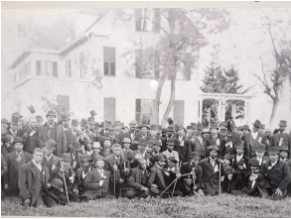 African American Civil War veterans visited James A. Garfield’s Mentor, Ohio, property during the 1880 “front porch” presidential campaign. The Garfield home is visible in the background. Garfield was one of the few Republicans still openly talking about race and civil rights as late as 1880. NPS
African American Civil War veterans visited James A. Garfield’s Mentor, Ohio, property during the 1880 “front porch” presidential campaign. The Garfield home is visible in the background. Garfield was one of the few Republicans still openly talking about race and civil rights as late as 1880. NPSInstead of galloping across America like today’s candidates, Garfield hatches a peculiar plan: he plops his presidential campaign right on his front porch in Mentor, Ohio. Why this porch-based political experiment? Garfield had some health hiccups and had been wrestling with a nasty bug. He wasn’t keen on bouncing around in dusty train cars and eating greasy takeout. His brilliant solution? Bring the people to him. It also allowed him to connect with voters in a more personal way, because nothing says ‘trust me with nuclear code’ like letting strangers sit in your wicker lawn chair and drink lemonade.
People from all walks of life flocked to Garfield’s home. Farmers, families, Civil War veterans, and curious onlookers came to hear him speak and shake his hand. It was like a mini-festival, with everyone invited. Notable Republicans and campaign managers were there too, helping to strategize and gather support. Think of them as party planners, ensuring everything ran smoothly while Garfield charmed the crowd. Reporters and journalists were also on hand to cover this unusual campaign style.
From his front porch, Garfield tackled weighty matters like civil service reform, economic policy, and educational initiatives, but framed them through the lens of ordinary Americans’ daily struggles. He’d often pause mid-speech to share a humorous tale about his childhood or quote folk wisdom, transforming complex political discourse into kitchen-table conversation.
The strategy proved remarkably effective. As autumn leaves fell and election day approached, the steady stream of visitors departing Mentor carried not just pamphlets and campaign buttons, but also a sense that they’d met not a politician but a neighbor who understood their concerns.
Where Was Chester? Chester Alan Arthur- National Portrait Gallery, Smithsonian Institution; gift of Mrs. Harry Newton Blue.
Chester Alan Arthur- National Portrait Gallery, Smithsonian Institution; gift of Mrs. Harry Newton Blue.Chester A. Arthur– a man whose magnificent walrus mustache preceded him in any room- was a prominent figure in the Republican Party, known for his affiliation with the Stalwarts faction. At the time of Garfield’s nomination, Arthur served as the Collector of the Port of New York. This position afforded him significant influence, connections, and the ability to wear absurdly opulent suits without a hint of irony. As Roscoe Conkling’s right-hand man, Arthur navigated party politics with the precision of a socialite selecting the perfect pair of riding gloves.
Although Arthur was not the leading campaign strategist–preferring to spend his evening enjoying the finer things in life–he nevertheless proved instrumental in corralling Stalwart supporters behind Garfield. With the panache of a circus ringmaster, he orchestrated delicate peace talks between the stuffy Stalwarts and the reform-obsessed Half-Breeds, who mixed like oil and vinegar at a church picnic.
Arthur’s true genius emerged in fundraising, where his New York Connection, cultivated during legendary midnight feasts at high-priced restaurants, opened wallets faster than a pickpocket on payday.
As Garfield held court on his front porch, Arthur took to the road. He delivered speeches in his oddly high-pitched voice that belied his imposing physical stature, charming Stalwart cronies with inside jokes about Conkling’s vanity and impromptu Shakespeare recitations. Arthur’s flamboyant presence, always impeccably dressed despite the campaign’s trail’s rigor, somehow convinced party loyalists that the reserved Garfield might not be such a bore after all.
A Close Election
The 1880 presidential election revealed a nation still nursing its Civil War wounds. Garfield’s opponent, the Democratic General Winfield Scott Hancock, had earned bipartisan admiration through his battlefield valor. As Americans cast their ballots, they faced a country beset by economic turmoil and scandal-plagued administrations. The electorate grappled with competing visions for government service, tariff policies, and how-or whether- to complete the abandoned promise of true reunification with the former Confederate states.
In the end, Garfield secured 214 Electoral College votes to Hancock’s 155, a margin that belied the true closeness of the contest. The popular vote revealed an even narrower divide: Garfield received approximately 4.4 million votes (48.3%), while Hancock received 4.2 million (47.6%). With less than 10,000 votes separating the candidates, fewer than the population of a small city, the election outcome was a coin toss to the very end.
Side Note: The final count is often debated, but everyone agrees that Garfield won by the smallest of margins. The numbers I provided are from the National Parks Service and the National Archives.
Taking Center StageGarfield’s elation mingled with a sobering awareness of duty. The Oval Office loomed before him—not merely a prize to be won, but a pulpit from which to champion reform and confront the nation’s ills. Contemporary accounts suggest he drew quiet satisfaction from the voters’ endorsement, viewing their ballots as both affirmation and directive. Yet even as champagne corks popped, his mind cataloged the fractures within his own party and the obstacles that would inevitably arise. This characteristic balance of optimism and pragmatism—celebration tempered by foresight-reveals the contemplative man behind the politician’s smile.
On March 4, 1881, James A. Garfield took the oath of office amid an atmosphere electric with anticipation. Standing before the gathered crowd, he delivered an inaugural speech that wove together aspirations of national healing and governmental transformation—a blueprint for the administration he envisioned.
Time, however, was not on his side.
Click here to read his Inaugural Address.
Final ThoughtsI’ve always found President Garfield’s life story deeply moving. His rise from poverty to presidency reads like something out of a storybook-a farm boy who worked his way through college, became a respected scholar and soldier, and eventually ascended to the nation’s highest office.
Tragically, Garfield’s narrative was cut short just as it began. His assassination represents such a pivotal moment in American history that we must examine it thoroughly; the cast of characters surrounding his death, the catastrophic medical decisions that followed, the courtroom battles over his assassin’s sanity, and how those 199 days between inauguration and death transformed not just a presidency, but a nation’s understanding of itself.
Until next time, Keep Reading and Stay Caffeinated.
Subscribe below to stay up to date on myths, legends, mysteries, and the chaos of history.
FacebookThreadsInstagramAmazonXYouTube
If you’re looking for your next favorite read, I invite you to check out my book, The Raven Society. This spellbinding historical fantasy series takes us on a heart-pounding journey through forgotten legends and distorted history. Uncover the chilling secrets of mythology and confront the horrifying truths that transformed myths into monstrous realities. How far will you go to learn the truth?
The Writer and The Librarian (Book 1):
Signed copies at:
https://rlgeerrobbins.com/product/the-writer-and-the-librarian-the-raven-society-book-1/
Explore more blogs here:
November 13, 2025The True Origins of Thanksgiving: Myths and RealitiesFrom Sarah Hale's famous nursery rhyme to Lincoln's proclamation, Roosevelt's date-shift, and the Pilgrims' harvest feast—these seemingly disparate threads of … July 4, 20254th of July: From Patriotism to CommercialismThe cost of Independence was not free. It was paid for by the sweat and blood of over 376,000 lives. … April 27, 2025The Surprising History of Maypole RibbonsDid you know you could have a Maypole with no ribbons and still celebrate May Day? And still be historically … October 10, 2023Unique Gravestones: Tales Behind Famous MonumentsGravestones reveal a great deal about the deceased and the living. Let's explore some of the more unique ones that …Sources:
The Front Porch Campaign of 1880 (U.S. National Park Service)
How Might the 1880 Election Have Gone Differently? (U.S. National Park Service)
Chester A. Arthur | The White House
Chester A. Arthur: Campaigns and Elections | Miller Center
The post Exploring James A. Garfield: The Beginning of a Tragic Tale appeared first on Chasing History.
November 13, 2025
The True Origins of Thanksgiving: Myths and Realities
Friends
Every fourth Thursday of November, Americans engage in a peculiar ritual of stuffing turkeys before stuffing themselves, all while pretending to care about football and avoiding political discussions with the father-in-law.
This gravy-soaked celebration supposedly traces back to some peaceful feast between Pilgrims and Native Americans-thought history tells a far messier tale-and has since morphed into a strange amalgamation of gratitude, gluttony, and doorbuster sales that somehow defines our national character.
Back StoryThe traditional American narrative places the first Thanksgiving in 1621, following a devastating winter in which disease and exposure killed approximately half of the English religious refugees who had founded Plymouth Colony in 1620.
History often glosses over how woefully unprepared the Pilgrims were upon arrival—dressed in thin garments better suited for English summers, their food supplies nearly exhausted, and utterly ignorant of how to cultivate the unfamiliar soil. Their famous feast likely commemorated not merely thankfulness, but their astonishment at having survived at all.
Textbooks also often skim over how the Pilgrims would have been toast without the Wampanoag people—these indigenous neighbors who basically ran a crash course in “How Not To Die In New England 101.” While the colonists fumbled with unfamiliar soil, the Wampanoag taught them to plant corn with dead fish as fertilizer (smelly but effective!), showed them which local berries wouldn’t give them explosive diarrhea, and essentially babysat a bunch of city dwellers who arrived woefully unprepared for wilderness survival.
 Massasoit, the Wampanoag Indian chief who maintained peaceful relations with the English in the area of Plymouth, Massachusetts, visits the Pilgrims. (Bettman / Getty)
Massasoit, the Wampanoag Indian chief who maintained peaceful relations with the English in the area of Plymouth, Massachusetts, visits the Pilgrims. (Bettman / Getty)November 27,
Dinner featured venison, some prehistoric-looking ocean bugs (shellfish), and whatever birds they could whack with a stick (definitely not our plump, domesticated butterballs). No pumpkin pie in sight—unless you count plain, boiled squash as “dessert.” And nobody was shouting “Happy Thanksgiving!” across the table—this was a Harvest Celebration. Or as I like to call it- a celebration of not starving.
Side Note: For those interested in learning more about the Wampanoag people, the Mashpee Wampanoag tribe—one of only three surviving tribes from what was once a nation of sixty-nine—maintains a comprehensive website detailing their history, culture, and ongoing presence in America. Click here to visit.
Colonial and Early U.S. Period The proclamation was printed in newspapers, including the October 9, 1789, issue of the Pennsylvania Packet and Daily Advertiser.
The proclamation was printed in newspapers, including the October 9, 1789, issue of the Pennsylvania Packet and Daily Advertiser.Back when America was just a baby in colonial diapers (1600s-1700s), folks would randomly declare “Hey, it’s Thanksgiving!” whenever something good happened. Rain? Thanksgiving! Corn didn’t die? Thanksgiving! Managed to shoot more British soldiers than they shot you? Oh, you better believe that’s a Thanksgiving!
After we kicked King George III to the curb, George Washington (the OG George) decided on November 26, 1789, that the whole country should have one big gratitude party for surviving the Revolutionary War and inventing a new government.
But like that weird uncle who visits only when he feels like it, Thanksgiving didn’t show up regularly yet.
To read the Thanksgiving Proclamation of 1789 click here.
A Little Lamb and a Famous Turkey Press and Sun-Bulletin
Press and Sun-BulletinBinghamton, New York • Sun, Nov 24, 1957 Page 9
Poet Sarah Josepha Hale—yes, the woman who unleashed “Mary Had a Little Lamb” upon generations of schoolchildren—had another peculiar obsession: badgering five consecutive U.S. presidents until they finally caved and made Thanksgiving official. From her perch as editor of Godey’s Lady’s Book (think Victorian-era Vogue, but with more corsets and moral instruction), she waged a decades-long turkey crusade that would make modern lobbyists blush.
She pestered five presidents with her turkey-day manifestos—poor Zachary Taylor, Millard Fillmore, Franklin Pierce, James Buchanan, and finally, the bearded wonder himself, Abraham Lincoln. Her quill never quit!
In 1863, while the nation was busy tearing itself apart, Hale launched her final epistolary assault on Lincoln’s inbox. Perhaps worn down by the relentless barrage of Thanksgiving propaganda (or possibly charmed by her turkey doodles in the margins), Honest Abe finally caved and proclaimed the last Thursday in November as the official day of thanks for Americans.
Hale hoped thanksgiving would serve as America’s emotional hearth—a day when the nation’s varied peoples could gather around common tables to break bread together, bow their heads in shared reverence, and collectively count their blessings, and creating bonds of unity.
Changes, Confusion, and Collective FrustrationIn a quirky Depression-era attempt to boost retail sales, President Franklin D. Roosevelt unilaterally shifted Thanksgiving forward by seven days in 1939—declaring the third Thursday of November as the new turkey day.
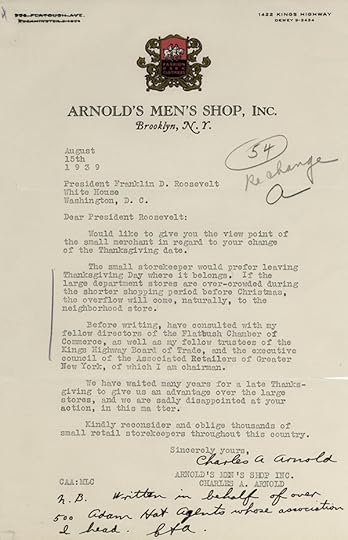
The calendar coup sparked nationwide chaos: 23 states refused to budge, creating a bizarre patchwork of dual Thanksgivings where families across state lines couldn’t coordinate dinners. Republicans mockingly dubbed it “Franksgiving,” while Atlantic & Pacific grocery stores printed calendars with both dates marked “Thanksgiving?”
“[S]ome governors declared November 30th as Thanksgiving. And so, depending upon where one lived, Thanksgiving was celebrated on the 23rd and the 30th. This was worse than changing the date in the first place because families that lived in states such as New York did not have the same day off as family members in states such as Connecticut! [And so] family and friends were unable to celebrate the holiday together.” -Franklin D. Roosevelt Presidential Library and Museum
Congress finally intervened in 1941, permanently anchoring the holiday to November’s fourth Thursday—where it has stubbornly roosted ever since.
To read FDR’s proclamation click here.
Final ThoughtsPoor Thanksgiving—the middle child of holidays, sandwiched awkwardly between Halloween’s sugar high and Christmas’s tinsel tsunami. It’s like that weird uncle nobody invites but who shows up anyway, expecting you to pretend you’re thrilled about his special cranberry-and-stale marshmallow casserole. We all just sit there, wallets already whimpering in anticipation of Black Friday, wondering if we can sneak away to the bathroom long enough to check Facebook or TikTok on our phones.
However, its blood-soaked history screams the vital importance of this day for our nation’s very soul! When we confront the raw, primal reasons for our celebration—the desperate clawing for survival against impossible odds, the life-or-death alliances forged in the wilderness, the revolutionary act of defining our destiny as a sovereign people—we must acknowledge that Thanksgiving isn’t just a holiday, it may be the beating heart of American identity.
Until next time, Keep Reading and Stay Caffeinated.
Subscribe below to stay up to date on myths, legends, mysteries, and the chaos of history.
FacebookThreadsInstagramAmazonXYouTube
If you’re looking for your next favorite read, I invite you to check out my book, The Raven Society. This spellbinding historical fantasy series takes us on a heart-pounding journey through forgotten legends and distorted history. Uncover the chilling secrets of mythology and confront the horrifying truths that transformed myths into monstrous realities. How far will you go to learn the truth?
The Writer and The Librarian (Book 1):
Signed copies at:
https://rlgeerrobbins.com/product/the-writer-and-the-librarian-the-raven-society-book-1/
Explore more blogs here:
November 10, 2020Veterans Day – Thank you to those who serve!I have been knee deep in prepping for Veterans Day this year. I have had an amazing group of friends, co-workers, … December 3, 2020Rudolph the Red- Nose Reindeer and the Man who Created Him.The tale of Rudolph's creation reflects personal struggles, societal needs, and triumph over adversity, transforming into a beloved American classic.December 7, 2020December 7th- Pearl Harbor Remembrance DayI will be the first to say that I usually only remember December 7 importance because of Facebook and small print … December 17, 2020Unpacking the Twelve Days of Christmas MeaningLet's explore the origins and meanings of “The Twelve Days of Christmas,” revealing its connections to religion, economics, and culture, while …Sources:
“Thanksgiving Proclamation, 3 October 1789,” Founders Online, National Archives, https://founders.archives.gov/documents/Washington/05-04-02-0091. [Original source: The Papers of George Washington, Presidential Series, vol. 4, 8 September 1789 – 15 January 1790, ed. Dorothy Twohig. Charlottesville: University Press of Virginia, 1993, pp. 131–132.]
Thanksgiving | George Washington’s Mount Vernon
Thanksgiving Belongs to the Wampanoag Tribe – The Atlantic
The post The True Origins of Thanksgiving: Myths and Realities appeared first on Chasing History.
November 9, 2025
The Evolution of Black Friday: From Chaos to Shopping Craze
Friends
The history of Black Friday unfolds like an American epic story-from its murky origins in 1950s Philadelphia, where police officers grimly dubbed post-Thanksgiving chaos, to today’s midnight doorbusters where shoppers camp in freezing parking lots before dawn, clutching coffee thermoses and sale fliers like treasure maps.
What began as a retailer’s desperate year-end push for profitability has morphed into a cultural phenomenon where economic forces, marketing psychology, and consumer frenzy collide in a perfect storm of capitalism.
Back Story The “Boy of the period” Stirring up the Animals, 1869. Currier & Ives. Library of Congress Prints and Photographs Division.
The “Boy of the period” Stirring up the Animals, 1869. Currier & Ives. Library of Congress Prints and Photographs Division.Wall Street trembled on September 24, 1869, when the gold-hoarding scheme of financiers Jay Gould and Jim Fist collapsed spectacularly. The pair had quietly amassed vast quantities of the precious metal, strangling supply and sending prices soaring-until Present Ulysses S. Grant intervened and released government reserves into the American market.
Gold’s value plummeted within minutes, dragging the stock exchange down with it. Fortunes evaporated by the afternoon. Ruined investors wandered the financial district in shock, giving this catastrophe its enduring name: the first ‘Black Friday‘ in American financial history.
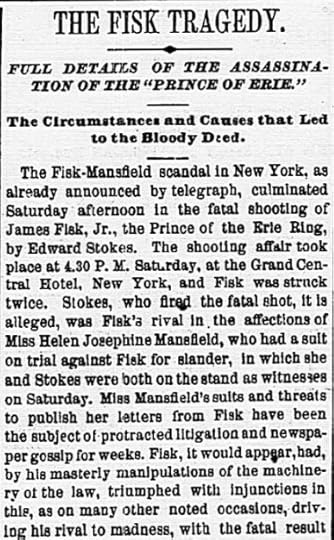 “THE FISK TRAGEDY,” The Charleston Daily News (Charleston, SC), January 10, 1872
“THE FISK TRAGEDY,” The Charleston Daily News (Charleston, SC), January 10, 1872The Black Friday scandal barely registered as a setback in Jay Gould’s ascent to wealth. By 1874, he owned the Union Pacific Railroad, soon followed by acquiring the Western Union Telegraph Company and the Manhattan Elevated Railroad.
For Jim Fisk, however, his fortune proved as fleeting as the stock market. His ascent into financial history ended abruptly in 1872 when Edward Stokes, a business associate and rival for the attention of actress Josie Mansfield, took matters into his own hands and silenced the flamboyant financier forever.
Side note: Fisk’s murder sent shockwaves through newsroom across the globe. Barely a week after his death, readers of the New York Herald’s Sunday edition found themselves privy to the intimate correspondence between Fisk and Josie Mansfield, splashed across page three like fresh blood. Click here to read.
It continues with an Army-Navy Football Game Vintage 1966 Army Navy Football Poster, Veterans Gift, Military Reunion Wall Art
Vintage 1966 Army Navy Football Poster, Veterans Gift, Military Reunion Wall ArtPhiladelphia police in the 1950s grimaced at the mention of ‘Black Friday’- their grim nickname for the day after Thanksgiving when the city transformed into a gridlocked nightmare. Downtown streets choked with station wagons from the suburbs as holiday shoppers collided with out-of-town football fans arriving for the Army-Navy game.
Officers found themselves directing endless streams of pedestrians while cars honked in frustration, their shifts stretching long into the evening. The term reflected not celebration but exhaustion- a day that left the departments’ resources stretched paper-thin and officers counting the hours until the day was over.
Side Note: Although the local Philadelphia newspapers that I shifted through don’t appear to have used the term ‘Black Friday’ at the time, numerous online sources mention it. Looking though archival photographs of the city during the Army-Navy game, I can understand why police officers dreaded traffic duty downtown.
The congestion captured in those images would have tested anyone’s patience-especially a cop stuck directing that chaos for hours.
From Negative to PositivePicture this: a long holiday weekend, the house bursting with relatives. Great-aunt Edna interrupting Uncle Pete’s story for the third time while cousin Marcy’s twins race circles around the dining table.
The turkey’s been carved, the pie plates licked clean, yet somehow everyone’s still here. By Friday, the shared bathroom has become a war zone and the last of the coffee filters vanished hours ago.
What’s the emergency escape plan before someone mentions politics? The mall, naturally- where family togetherness dissolves into blessed, separate credit card transactions.
 The parking lot at Hickory Hollow Mall is full while potential shoppers circle the lanes hoping to find a spot as they kick off the holiday season Nov. 24, 1989, the day after Thanksgiving in in Nashville, Tenn.
The parking lot at Hickory Hollow Mall is full while potential shoppers circle the lanes hoping to find a spot as they kick off the holiday season Nov. 24, 1989, the day after Thanksgiving in in Nashville, Tenn.Freeman Ramsey Jr., The Tennessean Via USA TODAY Network
Retailers, sensing opportunity in the 1980s, cleverly rewrote the narrative. No longer a dreaded day of chaos, ‘Black Friday’ now celebrated the moment when businesses crosses from loss to profit- their accounting books shifting from red (negative) to black (positive).
This financial metaphor washed away the term’s chaotic origins, transforming Black Friday into America’s most anticipated shopping ritual, marked on calendars alongside national holidays.
Final ThoughtsI’ve managed to dodge the Black Friday battlefield my entire life. Maybe it was our empty bank account that kept us away. Maybe it was because the day after Thanksgiving meant another shift for dad at the naval yard. Or maybe it was just that my mother- all five foot one of her with hands that smelled like books and dish soap- would have sooner walked barefoot through snow than throw elbows for a discounted microwave.
Black Friday means different things to different people. For some, the memory of huddling in predawn darkness, trading gossip about neighbors over Styrofoam cups of cold coffee, becomes its own cherished ritual. Others recall the childlike thrill of being first in line to whisper wishes in Santa’s ear, securing their place in the holiday hierarchy before the masses arrive.
The day is what you make of it. Enjoy the memories how ever you choose. Maybe the black eye is worth the 90 inch screen t.v. discounted by $30.00. I know my husband thinks so.
Until next time, Keep Reading and Stay Caffeinated.
Subscribe below to stay up to date on myths, legends, mysteries, and the chaos of history.
FacebookThreadsInstagramAmazonXYouTube
If you’re looking for your next favorite read, I invite you to check out my book, The Raven Society. This spellbinding historical fantasy series takes us on a heart-pounding journey through forgotten legends and distorted history. Uncover the chilling secrets of mythology and confront the horrifying truths that transformed myths into monstrous realities. How far will you go to learn the truth?
The Writer and The Librarian (Book 1):
Signed copies at:
https://rlgeerrobbins.com/product/the-writer-and-the-librarian-the-raven-society-book-1/
Explore more blogs here:
November 13, 2025The True Origins of Thanksgiving: Myths and RealitiesFrom Sarah Hale's famous nursery rhyme to Lincoln's proclamation, Roosevelt's date-shift, and the Pilgrims' harvest feast—these seemingly disparate threads of American … October 28, 2025Unveiling the Bilderberg Group: Conspiracy Theories and RealityThe Bilderberg Meeting, founded in 1954, gathers 130 leaders annually under confidentiality, fostering discussions on key geopolitical issues. Critics label it … October 19, 2025The Haunting Power of Curses Through HistoryCurses have ripped through the fabric of urban tales and folklore as weapons of vengeance, shields against evil, and harbingers of … October 12, 2025Exploring One Of America’s Most Haunted House: The Whaley HouseLocals call it America's Most Haunted House, but the Whaley House legacy is more than a simple family home in Old …Sources:
History of Black Friday | CNN Business
The History and Importance of Black Friday | Walden University
Black Friday, September 24, 1869 | American Experience | Official Site | PBS
The post The Evolution of Black Friday: From Chaos to Shopping Craze appeared first on Chasing History.
November 2, 2025
Uhtred the Bold: The Real Inspiration Behind the Fictional Warrior
Friends
The character of Uhtred of Bebbanburg, made famous by Bernard Cornwell’s The Last Kingdom series and its television adaptation on Netflix, is one of the most compelling figures in modern historical fiction. His story of loyalty, identity, and survival during the Viking Age captivates audiences around the world. Yet, behind this fictional hero lies a real historical figure: Uhtred the Bold, an Ealdorman of Northumbria who lived during the late 10th and early 11th centuries.
The Historical Uhtred the BoldUhtred the Bold, also known as Uhtred of Bamburgh, was a powerful Anglo-Saxon nobleman who ruled as Ealdorman of Northumbria. Born around 970 AD, he rose to prominence during a turbulent period in English history, when the kingdom faced constant threats from both the Scots to the north and the Danes to the east.
 The name of Uhtred, Earl of Northumbria as it appears on folio 153r of British Library Cotton MS Tiberius B I (the “C” version of the Anglo-Saxon Chronicle): “Uhtrede eorle”.
The name of Uhtred, Earl of Northumbria as it appears on folio 153r of British Library Cotton MS Tiberius B I (the “C” version of the Anglo-Saxon Chronicle): “Uhtrede eorle”.As Ealdorman, Uhtred was responsible for defending the northern frontier of England. He gained recognition for his military skill and leadership, particularly in battles against the Scots. Historical records suggest that he successfully defended Durham from a Scottish invasion, earning him both prestige and influence in the region. His authority extended across much of Northumbria, making him one of the most powerful men in northern England.
A Life of Power and AmbitionUhtred’s life was marked by both political ambition and shifting alliances. Like many nobles of his time, he navigated a complex web of loyalties between the English kings and the invading Danes. His marriages also reflected the political strategies of the era, as he sought to strengthen his position through alliances with influential families.
In 995, Uhtred the Bold received the hand of Ecgfrida, daughter of Bishop Aldhun of Durham, as reward for transporting Saint Cuthbert‘s holy remains to Durham’s newly constructed cathedral. The union brought Uhtred considerable wealth in the form of church lands. Though the marriage produced an heir—their son Ealdred—Uhtred would eventually cast Ecgfrida aside.

Prior to finalizing his separation from Ecgfrida, Uhtred had already wed Sige, the daughter of Styr Ulfsson of York, in the year 1004. Though this union produced two sons—Eadulf and Gospatric—it ultimately crumbled when Uhtred neglected his sworn obligation to Styr. The marriage agreement had hinged upon Uhtred’s vow to eliminate Thurbrand, a man for whom Styr harbored unmatched hatred. When Uhtred failed to complete his mission, Sige returned home.
Following King Sweyn Forkbeard’s death, Uhtred formed an alliance with Æthelred the Unready, cementing this bond through his marriage to Æthelred’s daughter Ælfgifu. Their union produced a daughter, Ealdgyth, whose subsequent marriage to Maldred—brother to King Duncan I of Scotland—established a bloodline that would later give rise to prominent Scottish noble houses, including the Earls of Dunbar and the Clan Hume/Home.
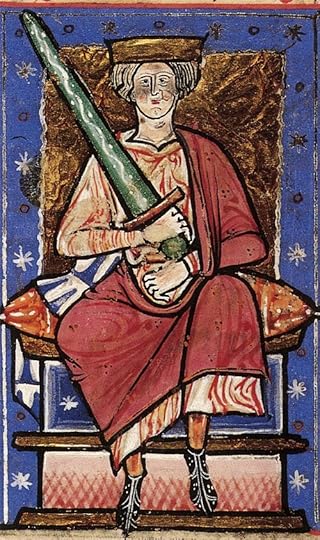 Æthelred II the Unready in an early thirteenth-century copy of the
Abingdon Chronicle
A Bloody End
Æthelred II the Unready in an early thirteenth-century copy of the
Abingdon Chronicle
A Bloody EndDespite his power, Uhtred’s life ended violently. Around 1016, during the reign of King Cnut (Canute) of Denmark, Uhtred was assassinated in an ambush.
Though Uhtred first stood firm in his loyalty to King Æthelred, he eventually bent his knee to Cnut. Believing Cnut’s promise of peace, Uhtred attended a meeting only to walk into a trap—Thurbrand the Hold and his warriors cut down Uhtred and his men where they stood. Many whispered that Cnut had sanctioned the slaughter, mistrusting Uhtred’s shifting allegiances. As one of Cnut’s staunchest allies, Thurbrand may have also carried old grudges against Uhtred.
Blood called for blood; Uhtred’s son Ealdred eventually drove his blade through Thurbrand’s heart, only to later fall to Thurbrand’s son Carl’s sword. Thus began a vendetta that would stain the soil red for generations to come.
The Fictional Uhtred of Bebbanburg
Bernard Cornwell’s fictional Uhtred of Bebbanburg draws heavily from the legend of Uhtred the Bold but reimagines him in an earlier period, during the 9th century. In The Last Kingdom series, Uhtred is portrayed as a Saxon noble captured and raised by Danes, torn between two worlds—his Saxon heritage and his Viking upbringing. This internal conflict forms the heart of his character and drives much of the story’s drama.
While the fictional Uhtred shares the name and Northumbrian roots of his historical counterpart, their lives differ significantly. The real Uhtred lived during the time of King Æthelred the Unready and King Cnut, whereas Cornwell’s Uhtred interacts with figures like King Alfred the Great, who lived more than a century earlier. The fictional narrative compresses and reimagines history to create a sweeping saga of England’s formation.
Final ThoughtsThe connection between the two Uhtreds lies not in precise historical accuracy but in spirit. Both embody the fierce independence and warrior ethos of Northumbria—a region that often stood apart from the rest of England. Through Cornwell’s storytelling, the name Uhtred has been revived, linking modern audiences to a real figure whose courage and fate were once recorded in medieval chronicles.
Uhtred the Bold’s legacy endures not only in history books but also in popular culture, where his fictional descendant continues to fight for Bebbanburg and for the soul of England. The blending of fact and fiction ensures that the story of Uhtred—both real and imagined—remains a powerful symbol of resilience, loyalty, and the enduring struggle for identity in a changing world.
Get your own copy of The Last Kingdom here.
Until next time, Keep Reading and Stay Caffeinated.
Subscribe below to stay up to date on myths, legends, mysteries, and the chaos of history.
FacebookThreadsInstagramAmazonXYouTube
If you’re looking for your next favorite read, I invite you to check out my book, The Raven Society. This spellbinding historical fantasy series takes us on a heart-pounding journey through forgotten legends and distorted history. Uncover the chilling secrets of mythology and confront the horrifying truths that transformed myths into monstrous realities. How far will you go to learn the truth?
The Writer and The Librarian (Book 1):
Signed copies at:
https://rlgeerrobbins.com/product/the-writer-and-the-librarian-the-raven-society-book-1/
Explore more blogs here:
October 28, 2025Unveiling the Bilderberg Group: Conspiracy Theories and RealityThe Bilderberg Meeting, founded in 1954, gathers 130 leaders annually under confidentiality, fostering discussions on key geopolitical issues. Critics label it … October 5, 2025Unveiling the Knights Templar: Secrets of a Shadowy BrotherhoodThe Knights Templar, a powerful brotherhood formed to protect pilgrims, amassed considerable influence and wealth, leaving an enduring legacy. But do … September 7, 2025Unraveling the Whitechapel Murders: A Lasting FascinationFive women met violent deaths in London’s Whitechapel district during the autumn of 1888. So, why do we only remember the … August 28, 2025Roosevelt Island’s Smallpox Hospital- A Bleak Reminder of a World Epidemic.Roosevelt Island's Smallpox Hospital—a crumbling Gothic fortress where the screams of the dying once echoed through quarantine wards, now stands as …Sources:
The Roman Origins of the Viking Age – Museum of Cultural History
Uhtred the Bold, ealdorman of Northumbria
THE SUCCESSION IN THE KINGDOM OF STRATHCLYDEION
The post Uhtred the Bold: The Real Inspiration Behind the Fictional Warrior appeared first on Chasing History.
October 28, 2025
Unveiling the Bilderberg Group: Conspiracy Theories and Reality
Friends,
The Bilderberg Meeting, first convened in 1954, serves as an annual gathering where European and North American leaders engage in candid conversation. Each year, roughly 130 attendees—spanning government, business, finance, organized labor, universities, and news organizations—receive invitations to participate.
The Meetings operate under a strict confidentiality protocol known as the Chatham House Rule, allowing attendees to utilize discussed information while prohibiting any disclosure of who said what or which organizations were represented.
This perhaps explains why many regard the Bilderberg Group as standing at the pinnacle of secret societies.
Background Named after the hotel in the Netherlands (pictured) where the first conference was held in 1954
Named after the hotel in the Netherlands (pictured) where the first conference was held in 1954The inaugural gathering took place at Hotel De Bilderberg in Oosterbeek, Netherlands, May 29-31, 1954. Despite the Conference’s focus on Western European and U.S relations, no U.S. politician was present. Nevertheless, participants proceeded with an open forum before addressing specific approaches to key issues causing friction between the regions.
1. The general attitude towards Communism and Soviet Russia.
2. Unification of Europe.
3. European Defense Community and European Defense.
4. Problems of Overseas Territories.
5. Economic problems.
When powerful figures meet behind closed doors without accountability, people naturally fill the information vacuum with dark suspicions—from whispers of shadowy cabals to elaborate theories about hidden global power structures orchestrating world affairs.

As an ‘invite-only’ meeting, elected officials mingle with business leaders and banking magnates in an atmosphere that facilitates undisclosed influence-peddling and favoritism, operating beyond the reach of public scrutiny.
Though casual conversations between leaders may seem harmless, shutting out citizens from discussions that impact their lives undermines the fundamental principle that those governed should have a voice in governance.
Critics argue these gatherings function as echo chambers where powerful figures reinforce shared ideologies like economic policies, creating an illusion of widespread agreement among decision-makers.
New World Order?Conspiracy theorists have long claimed the Bilderberg Group orchestrates a shadowy agenda toward world domination, with provocateurs like Alex Jones trumpeting these allegations:
“[they]manufactured economic crises, sophisticated surveillance tech and—above all—inside-job terror attacks that fuel exploitable hysteria” –Rolling Stones
 Cover of The Jewish Peril: The Protocols of the Learned Elders of Zion, published in London, 1920.
Cover of The Jewish Peril: The Protocols of the Learned Elders of Zion, published in London, 1920.According to conspiracy theorists, legitimate international bodies such as the United Nations, the Council on Foreign Relations, and the Bilderberg Group serve as mere facades for a shadowy cabal. These accusations frequently target well-known Jewish individuals and families—particularly the Rothschilds—without any factual basis.
Such conspiratorial thinking can be traced back to anti-Semitic fabrications that emerged in the 19th and 20th centuries, with the most infamous example being The Protocols of the Elders of Zion, a thoroughly debunked document that purported to reveal a Jewish conspiracy for world control.
When was the New World Order ‘established?’Following the devastation of the Great War, President Wilson envisioned a transformed international landscape he termed the “New World Order.” His blueprint, articulated through fourteen key principles, placed the League of Nations at its heart. Wilson believed that transparent diplomatic channels, unrestricted commerce, the right of peoples to govern themselves, and an international forum for conflict resolution would safeguard global peace.
 The League of Nations: A Pictorial Summary, Geneva: League of Nations, c. 1920. (Courtesy of the Woodrow Wilson House)
The League of Nations: A Pictorial Summary, Geneva: League of Nations, c. 1920. (Courtesy of the Woodrow Wilson House)Yet this ambitious re-imagining of world affairs faltered when isolationist sentiment in the Senate blocked American participation in the League itself.
Winston Churchill on March 5, 1946 spoke at Westminster College, Fulton, Missouri and said the following:
Now, while still pursuing the method of realizing our overall strategic concept, I come to the crux of what I have traveled here to Say. Neither the sure prevention of war, nor the continuous rise of world organization will be gained without what I have called the fraternal association of the English-speaking peoples. This means a special relationship between the British Commonwealth and Empire and the United States. – Winston Churchill
Addressing a joint session of Congress on September 11, 1990—during the initial “Desert Shield” operations preceding the Gulf War—President George H.W. Bush outlined his vision for a “new world order” with these words:
Is Bilderberg a major player in politics?“Out of these troubled times, our fifth objective-a new world order-can emerge: a new era, free from the threat of terror, stronger in the pursuit of justice, and more secure in the quest for peace. An era in which the nations of the world, East and West, North and South, can prosper and live in harmony.” -President G.H.W. Bush
Those who subscribe to conspiracy narratives often suggest that an invitation to Bilderberg functions as a tacit approval for political hopefuls. According to this perspective, the gathering effectively “blesses” emerging leaders, who subsequently receive backing from influential circles to secure governmental leadership roles.
However, when interviewed by the Georgetown Journal of International Affairs in February 2025, researcher Lukas Kantor concluded that the evidence linking Bilderberg attendance to subsequent political ascension remained largely circumstantial.
How many meetings have there been?Since its inception in 1954, the Bilderberg Group has convened seventy-one times, with the most recent gathering in June 2025. Only three times in seven decades has the annual rhythm been broken: once in 1976 when Lockheed’s bribery scandals made discretion impossible, and twice during the global paralysis of COVID-19.
Final ThoughtsWhile the Bilderberg Meeting maintains significant privacy protocols, it doesn’t hide its existence, yearly gathering places, attendee lists, or broad discussion topics from public view. What remains behind closed doors—the actual conversations protected by confidentiality agreements—creates the vacuum where conspiracy theories and wild speculation flourish.
Secret societies aren’t inherently criminal; people gather for private conversations all the time. What raises eyebrows is the selection process —no discernible pattern to who receives an invitation, no application to submit, no way to nominate yourself for consideration. Through the apparent randomness, one pattern emerges clearly: those welcomed inside invariably possess substantial wealth and influence.
And that alone is what makes the Bilderberg group dangerous.
Until next time, Keep Reading and Stay Caffeinated.
Subscribe below to stay up to date on myths, legends, mysteries, and the chaos of history.
FacebookThreadsInstagramAmazonXYouTube
If you’re looking for your next favorite read, I invite you to check out my book, The Raven Society. This spellbinding historical fantasy series takes us on a heart-pounding journey through forgotten legends and distorted history. Uncover the chilling secrets of mythology and confront the horrifying truths that transformed myths into monstrous realities. How far will you go to learn the truth?
The Writer and The Librarian (Book 1):
Signed copies at:
https://rlgeerrobbins.com/product/the-writer-and-the-librarian-the-raven-society-book-1/
Explore more blogs here:
October 8, 2025Unveiling Skull & Bones: America’s Secret SocietyEach year, fifteen of Yale's most promising seniors receive a tap on the shoulder—an invitation to join Skull and Bones, the … October 5, 2025Unveiling the Knights Templar: Secrets of a Shadowy BrotherhoodThe Knights Templar, a powerful brotherhood formed to protect pilgrims, amassed considerable influence and wealth, leaving an enduring legacy. But do …Sources:
Homepage– Bilderberg
BilderbergConferenceReport1954.pdf
The New World Order – M.J. Bonn, 1941
The post Unveiling the Bilderberg Group: Conspiracy Theories and Reality appeared first on Chasing History.
October 19, 2025
The Haunting Power of Curses Through History
This page contains sensitive content. Reader discretion is advised.
Friends,
Curses have haunted humanity since the dawn of civilization, their terrible power first unleashed by ancient Sumerians who etched vengeful warnings into clay tablets and Egyptians who promised horrific deaths to tomb raiders—their hieroglyphs promising that demons would devour violators’ hearts. Even the Book of Genesis trembles with divine wrath, condemning mankind to suffer through childbirth, to battle thorns and thistles, and ultimately to return to dust—perhaps the most devastating curse ever pronounced.
Curses have ripped through the fabric of urban tales and folklore’s as weapons of vengeance, shields against evil, and harbingers of doom, erupting in countless manifestations across civilizations—from whispered maledictions that shatter lives to blood-soaked rituals performed under moonless skies, from hexes that haunt generations to legendary imprecations that toppled empires and brought gods to their knees.
But do curses really exist? Or are they a figment of our imagination?
A Tale as Old As TimeResearchers, headed by Alexander Hollann of the University of Washington, have discovered that a humble grocery seller- not royalty or nobility-was the target of a blistering curse etched into a slender plate of lead nearly two thousand years ago in during the Ancient Roman Empire.
 Image credit: Photo courtesy Professor Alexander Hollmann
Image credit: Photo courtesy Professor Alexander HollmannThe inscribed curse tablet had been cast into a well in Antioch-at that time among the largest eastern metropolises of the Roman Empire, located in what is now Turkey’s southeaster region along the Syrian border.
Invoking Iao- the Greek name for Yahweh from the Old Testament- the inscription demands divine punishment for a greengrocer named Babylas. Ensuring that the right person was targeted, the tablet also identifies the man’s mother as Dionysia, ‘also known as Hesykhia.’
The cursed tablet, currently housed at Princeton University Art Museum, remained only partially deciphered since its excavation in the 1930s. Scholars completed a full translation, a detailed translation found in a issue of Zeitschrift für Papyrologie und Epigraphik, a journal specializing in ancient written material.
Translation of CurseSide A: Translation and Commentary
O thunder- and lightning-hurling Iao, strike, bind, bind together Babylas, the greengrocer, whom the polluted womb Dionysia, also called Hesykhia, gave birth to and who lives in the neighborhood of the Mygdonites. As you struck the chariot of Pharaoh, so strike his [Babylas’] of-fensiveness. O thunder- and lightning-hurling Iao, as you cut down the firstborn of Egypt, cut down his [livestock?] as much as… now, and bind, bind down, bind together, lay out, twist, let them be broken, let them not be able to move, the livestock of Babylas himself all the time from this hour and from this day, now, now, quickly, quickly, fill with evil fortune an this same Babylas the greengrocer, who Hesykhia gave birth to!
Side B: Translation and Commentary
I adjure you (pl.) on account of the lawless and impious Babylas the greengrocer: just you drown and will chill [this tablet] in the disused well, so too drown and chill the soul of Babylas, whom Dionysia, also known as Hesykhia, gave birth to, weighed down with illness an
useless wherever he will be, and let no-one live with him, now, now, quickly, quickly!
When the United States threatened his people and their allies, Tecumseh, who led a powerful alliance of Native American tribes, refused to back down. Though he fell in battle, whispers spread of a dying curse he laid upon American Presidents.
Strangely enough, for nearly two centuries afterward, presidents elected in years ending with zero died in office with eerie regularity. Coincidence? Or had Techumsh’s spirit reached across the veil to exact a terrible vengeance on the nation’s leaders?
William Harrison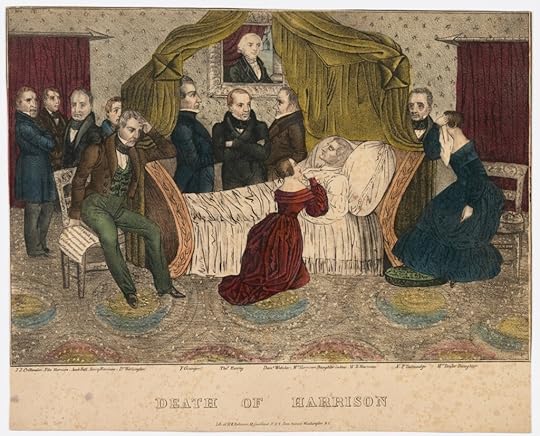 1841 Creator: Henry Robinson Lithograph.
1841 Creator: Henry Robinson Lithograph.National Portrait Gallery, Smithsonian Institution
In 1801, William Harrison took the helm as governor of the newly established Indiana Territory. Driven by ambitions of westward expansion, he soon found himself at odds with Tecumseh and the Native coalition that had formed to resist American encroachment. Nearly four decades later, Harrison claimed victory in 1840.
Harrison took office, though his tenure would prove fleeting. Standing hatless and coatless in the bitter March air, he delivered the longest inaugural address in American history- a two-hour oration that would cost him dearly. The chill that settled in his bones soon manifested into pneumonia which killed him one month after his inauguration.
He is still the shortest-serving U.S. president and considered the first victim of the Tecumseh curse.
Abraham Lincoln April 14, 1865.Library of Congress / Reuters
April 14, 1865.Library of Congress / ReutersActor and Confederate sympathizer John Wilkes Booth assassinated President Abraham Lincoln at Ford’s Theater on April 14, 1865- a tragedy etched into American consciousness. Lincoln had secured his second term in 1864, however he initially won the presidency in 1860. This initial election date places him squarely within the pattern of the curse.
The bullet to Lincoln’s skull proved fatal within nine hours, while Wilkes and his fellow plotters fled into the night. That same evening, William Henry Seward, Lincoln’s secretary of state, survived a coordinated assault on his life. Authorities determined that Booth, Powell (who attacked Seward), and at least three others had conspired to decapitate the Union government—their vengeance for the South’s defeat. Justice came swiftly; each conspirator met their end at the gallows or before a firing squad, Booth included.
James Garfield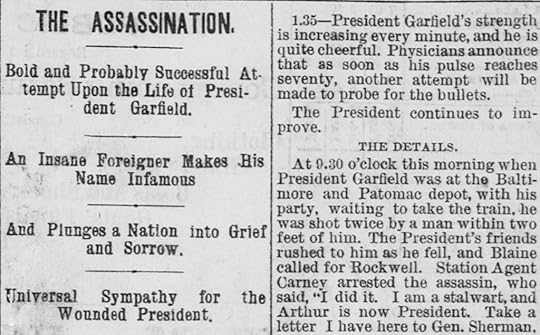 July 3, 1881 The Salt Lake Herald, Chronicling America: Historic American Newspapers.
July 3, 1881 The Salt Lake Herald, Chronicling America: Historic American Newspapers.On July 2, 1881, President Garfield (elected in 1880) strode through the Baltimore and Potomac train station, anticipating a restful holiday at the Jersey shore. The bustling crowd parted for the president until Charles Guiteau emerged from the travelers and fired twice. The fatal bullet tore through Garfield’s back, embedding itself in his abdomen where it would remain.
For two months, Garfield clung to life. Physicians, their unwashed hands delving into his wound in search of the bullet, subjected him to medical practices now considered barbaric. Infection, stemming both from the initial injury and these crude interventions, ultimately claimed him. After enduring weeks of agony and dramatic weight loss, the president succumbed on September 19.
Guiteau, despite pioneering the insanity defense in a high-profile case, found no mercy from the court—they convicted him and sent him to the gallows the following year.
William McKinleyWhen Leon Czolgosz fired his pistol at President William McKinley during the Pan American Exposition in Buffalo on September 6, 1901, few suspected the wounds would prove fatal. The self-proclaimed anarchist had waited in the receiving line, concealing his weapon beneath a handkerchief, determined to strike a blow against what he viewed as tyrannical government authority. As McKinley extended his hand in greeting, Czolgosz seized his moment.
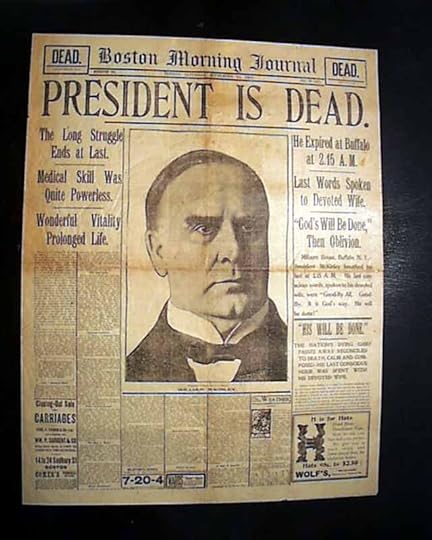 BOSTON MORNING JOURNAL, Sept. 14, 1901
BOSTON MORNING JOURNAL, Sept. 14, 1901 Despite his injuries, McKinley remained conscious and implored his security detail to show restraint toward his assailant while medical staff whisked him into an ambulance. Physicians initially believed the president would recover, as the bullet wounds appeared survivable. Unbeknownst to his medical team, however, infection had already begun spreading through the damaged tissue. Gangrene ultimately claimed McKinley’s life on September 14th, cutting short his second term, elected in 1900, after only half a year in office.
Warren Harding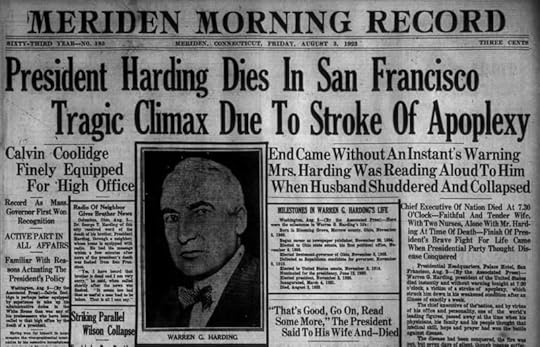 https://www.newspapers.com/paper/record-journal/24595/
https://www.newspapers.com/paper/record-journal/24595/In the weeks before his August 2, 1923 death, Warren Harding’s body was failing him, though he paid little mind to the warning signs. The 29th president, elected in 1920, attributed his fatigue to an arduous cross-country journey, dismissing the cardiac condition that had enlarged his heart. Meanwhile, the presidency itself became another strain on his system—the Teapot Dome scandal unfolding in newspaper headlines while whispers of his mistresses circulated through Washington’s parlors, each crisis another silent blow to his already compromised constitution.
On the evening of August 2, 1923, President Harding reclined in his San Francisco hotel room while Florence Harding, his wife, read aloud from a flattering newspaper article about him. “That’s good, go on,” he murmured—his final words before a violent tremor seized his body. By the time medical help arrived, the president had already passed away. Florence’s subsequent refusal to permit an autopsy fueled speculation about poisoning, though the official cause was listed as “cerebral apoplexy.”
Franklin Roosevelt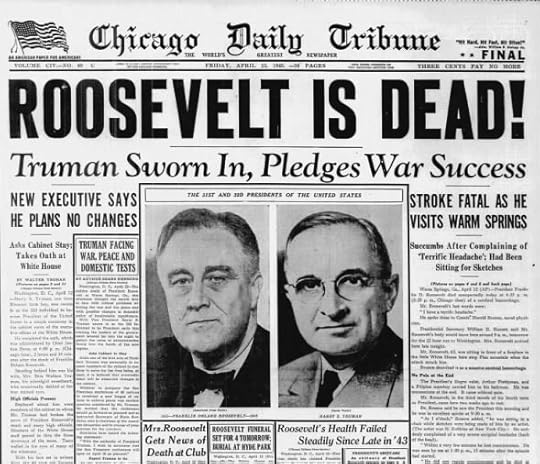 Chicago Daily Tribune
Chicago Daily TribuneThe American public knew well of Franklin Delano Roosevelt’s battle with polio, which had left him unable to stand without leg braces. Yet even as his body failed him, his resolve did not; FDR, elected in 1940 for his third term, navigated both personal hardship and national catastrophe, steering the country from the depths of economic collapse to the crucible of World War II.
While sitting for a portrait at his retreat in Warm Springs on April 12, 1945, Roosevelt complained of a sudden, severe headache. “I have a terrific pain in the back of my head,” were among his final words before he slumped forward, unconscious. The cerebral hemorrhage that struck without warning proved fatal; the President never regained consciousness.
John Kennedy President John F. Kennedy’s remains arrive in Washington, D.C., with Jacqueline and Robert Kennedy following the casket.
President John F. Kennedy’s remains arrive in Washington, D.C., with Jacqueline and Robert Kennedy following the casket.Keystone-France/Gamma-Keystone/Getty Images
Tecumseh’s Curse claimed John F. Kennedy in 1963, when bullets tore through the presidential motorcade in Dallas, creating perhaps the most conspiracy-laden and publicly dissected death of any cursed president.
Decades after the Kennedy assassination, speculation persists. Some wonder if the youthful commander-in-chief—navigating the treacherous waters of racial equality, the global space race, Soviet tensions, and Southeast Asian conflict—fell victim to an ancient hex that had claimed his forebears.
Ripley’s Believe It or NotThe pattern of presidential mortality first caught public attention in 1931 when Ripley’s Believe It or Not, highlighted the eerie likelihood, a theory that gained credibility as subsequent commanders-in-chief met their fates. While modern presidents appear to have escaped this grim tradition by a breath of good luck, the question lingers- has the curse truly been broken?
 Final Thoughts
Final ThoughtsScience has found no evidence that curses are real, yet millions remain convinced of their power through deeply-rooted psychological, cultural, and superstitious beliefs that refuse to die. The terrifying effects people attribute to curses often manifest through the devastating power of self-fulfilling prophecy—where the mere conviction that dark forces have marked you can destroy your life from within, creating the very suffering you feared most.
On the other hand, history has shattered our comfortable delusions, forcing us to confront how the most blood-curdling, mind-shattering impossibilities have repeatedly erupted into our reality, carving themselves into the bedrock of human truth with the force of a jackhammer through concrete.
To believe or not to believe….that is the real question.
Until next time, Keep Reading and Stay Caffeinated.
Subscribe below to stay up to date on myths, legends, mysteries, and the chaos of history.
FacebookThreadsInstagramAmazonXYouTube
If you’re looking for your next favorite read, I invite you to check out my book, The Raven Society. This spellbinding historical fantasy series takes us on a heart-pounding journey through forgotten legends and distorted history. Uncover the chilling secrets of mythology and confront the horrifying truths that transformed myths into monstrous realities. How far will you go to learn the truth?
The Writer and The Librarian (Book 1):
Signed copies at:
https://rlgeerrobbins.com/product/the-writer-and-the-librarian-the-raven-society-book-1/
Explore more blogs here:
October 28, 2025Unveiling the Bilderberg Group: Conspiracy Theories and RealityThe Bilderberg Meeting, founded in 1954, gathers 130 leaders annually under confidentiality, fostering discussions on key geopolitical issues. Critics label it … October 8, 2025Unveiling Skull & Bones: America’s Secret SocietyEach year, fifteen of Yale's most promising seniors receive a tap on the shoulder—an invitation to join Skull and Bones, the … October 5, 2025Unveiling the Knights Templar: Secrets of a Shadowy BrotherhoodThe Knights Templar, a powerful brotherhood formed to protect pilgrims, amassed considerable influence and wealth, leaving an enduring legacy. But do … September 14, 2025Exploring Washington’s Legendary CreaturesLurking in the shadows of Washington’s dense forests and misty coastlines is a distinction many overlook: a bestiary of legendary creatures.Sources:
Deciphered Ancient Tablet Reveals Curse of Greengrocer | Live Science
(PDF) A lexicographical note on a curse tablet from Antioch
Gen. William Henry Harrison, Tecumseh, and the Curse of History – The Dartmouth Review
Report of the Physicians | The American Presidency Project
The post The Haunting Power of Curses Through History appeared first on Chasing History.
October 12, 2025
Exploring One Of America’s Most Haunted House: The Whaley House
Friends,
Locals call it America’s Most Haunted House, but the Whaley House legacy is more than a simple family home in Old Town San Diego. Before Thomas Whaley laid the foundation stones, “Yankee Jim” Robinson swung from a gallows on that very ground. The Whaley’s moved in anyway. Soon after, young Thomas Jr.’s bedroom fell silent to scarlet fever. Daughter Violet took her own life. Between bankruptcy and a fire that nearly consumed everything, visitors now whisper of footsteps in empty hallways and phantom figures glimpsed through doorways—stories that cling to the museum walls to this day.
Yankee Jim RobinsonIn the summer of 1852, a tall, fair-haired Canadian known as Yankee Jim Robinson stepped foot in San Diego. The origin of his nickname remains unclear—some accounts suggest he earned it during his naval service before arriving in California in 1842, while others claim he acquired it later while searching for gold up north.
Yankee Jim’s motives for settling in San Diego remain contested. Some historians paint him as an affable fellow who, alongside two companions, simply sought new prospects in the growing coastal town. Others view his arrival more cynically—as a calculated stop on a criminal expedition that would culminate in a comfortable Mexican hideaway.
Public opinion of Yankee Jim would go from bad to worse when he attempted to steal a pilot boat docked in the San Diego Bay. Pursued by townsmen Yankee Jim escaped by stealing a rowboat and rowing himself across the bay to Point Loma. He was captured several hours later when he stopped at a ranch asking for food and water.
Hasty TrialThe county authorities wasted no time after the capture, bringing Yankee Jim and his companions to trial within days. Yankee Jim initially dismissed the proceedings as an elaborate prank meant to frighten him into contrition. How could he take it seriously? The very men who had pursued him across the bay now sat the jury box, and Judge Benjamin Hayes swayed visibly on the bench, obviously drunk during the whole proceedings.
Prosecutor James W. Robinson (no relation) opened the trial by accusing Yankee Jim of plotting to commandeer San Diego’s sole vessel for acts of piracy. Throughout the proceedings, Yankee Jim’s laughter disrupted the courtroom multiple times, requiring repeated admonishment. His amusement faded when, following brief deliberation, the jury delivered their verdict: death. Judge Hayes concurred, sentencing Yankee Jim to hang by the neck the following day.
 Photo Credit: Richard Schulte. Website: Cool San Diego Sights!
Photo Credit: Richard Schulte. Website: Cool San Diego Sights!On August 18th, at the future site of the Whaley House, Yankee Jim’s laughter finally ceased. The sight of the hemp noose erased any lingering belief that this was all some elaborate prank. Standing at six-foot-three, the Canadian towered over his executioners, a height that would prove fatal in the most gruesome way—the hastily constructed gallows lacked sufficient drop. For thirty agonizing minutes, his toes brushing the wagon below, Yankee Jim dangled between life and death, his breaths coming in ragged gasps until the final one escaped.
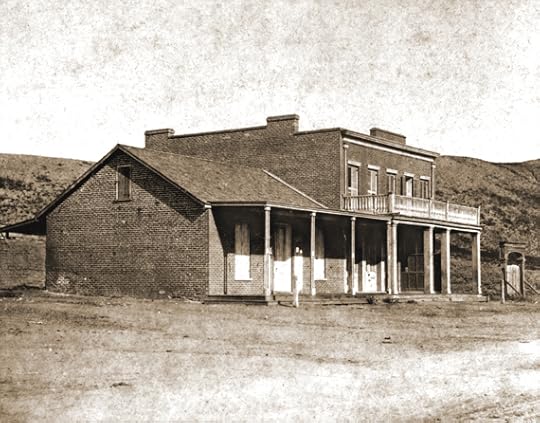 The earliest known photograph of the Whaley House, taken c. 1872. Courtesy SOHO collectionBuilding on Bloody Ground
The earliest known photograph of the Whaley House, taken c. 1872. Courtesy SOHO collectionBuilding on Bloody GroundThomas Whaley broke ground on his ambitious residence on May 6, 1856, boasting it would surpass any dwelling within a 150-mile radius in beauty, comfort, and convenience. He personally designed the Greek Revival structure, a two-story edifice constructed from bricks manufactured at his own Conde Street brickyard. When finished, the home—adorned with mahogany and rosewood furnishings, elegant Brussels carpets, and representing an investment exceeding $10,000—earned widespread acclaim as Southern California’s premier residence, unprecedented in its refinement.
But all that glitters is not gold.
Tragedy BeginsTragedy struck the Whaleys in the winter of 1858 when scarlet fever claimed their infant son Tommy before he reached his second birthday. Though summer brought new life with the birth of their daughter Anna Amelia within the brick walls of their home, autumn delivered yet another blow—flames, deliberately set by an unknown hand, reduced Mr. Whaley’s profitable storefront to ashes.
Grief-stricken by Tommy’s death and financially devastated by the fire, the Whaleys accepted an invitation from friends to rebuild their lives in San Francisco. Their house in Old Town remained unsold, prompting Whaley to entrust its care to his associate Squire Ensworth, who took up residence and supplemented his income by letting rooms to boarders.
Alaska BoundThe Whaley family expanded with the arrival of three more children in San Francisco: George Hay Ringgold, Violet Eloise (known as Vi), and Corinne Lillian. While serving briefly as a U.S. Army Commissary Storekeeper, Whaley’s duties took him to Sitka in Alaska Territory. There, he oversaw three government supply transports just before the American acquisition of October 18, 1867. Whaley participated in the ceremonial raising of the American flag on Japonski Island across from Sitka, and his standing in the community led to his unanimous election as a councilman.
Whaley journeyed back to San Diego, determined to persuade his family to abandon San Francisco and once again stake their future on the brick house that embodied his ambitions. His wife would not be moved.
The Show Must Go OnDesperate to find someone who would help with the financial burden of two households, Whaley crossed paths with Thomas Tanner, a showman who led the renowned Tanner Troupe of circus and vaudeville performers. By October 1868, the second floor of Whaley’s building had become home to the Tanners, with what had once been the family’s parlor and dining rooms on the western side now serving as San Diego’s first commercial theater.
 The Whaley House Theater as it is today, restored in 2001. Photo by Sandé Lollis
The Whaley House Theater as it is today, restored in 2001. Photo by Sandé LollisPromising weekly entertainment for the community, the Tanner Troupe Theater raised its curtains for the first time on December 2. Patrons paid 75 cents for reserved seating or 50 cents for general admission, with children’s tickets available at half price. Following the premiere, the San Diego Union published the following review:
Returning HomeTHE TANNER TROUPE. The performance of this troupe on last Wednesday evening, considering the circumstances, was very creditable. The house was filled to utmost capacity; which is a matter of congratulation to the manager; and all seemed pleased with this first attempt in this place, at least, at a theatrical performance. Notwithstanding the perfectly apparent indisposition of Mr. Tanner, the bronchial affliction of Miss Soledad, the rawness of the novices, the defective musical arrangements, the want of capacity in the seating room, and the smallness of the stage, we may be pardoned for saying that our theater is a success. Owing to the continued indisposition of Mr. Tanner the performance which he announced for tonight is postponed until Wednesday evening next, after which the troupe will perform nightly. –The San Diego Union, December 5, 1868.
The earth beneath San Francisco shuddered violently on October 21, 1868, and Anna Whaley’s resolve to stay crumbled with it. By December, she had gathered the children and boarded the steamship Orizaba bound for San Diego. The Tanner Troupe had barely established themselves, their October opening still fresh when tragedy struck. Merely a week after Anna’s return, Thomas Tanner, at fifty-six, took his final bow—found lifeless in his bed following an evening performance. With their leader gone, the troupe’s curtain fell for good in early 1869.
The Whaley family returned to the main two-story building in late 1869. Shortly thereafter, San Diego County officials transformed the old theater into meeting chambers for the Board of Supervisors. Meanwhile, the building found new purpose as the county’s second courthouse.
Whaley discovered more profit in transforming his failing general store into a drinking establishment. Writing to Anna on October 18, 1870, Thomas explained,
Tragedy Strikes Again“I am writing this in my Saloon and as the Court is in session, I am very busy, therefore you will excuse the shortness of this. I shall do very well keeping bar when the Court sits at other times, it will not pay to keep open, and as it now is I am open only from 9 to 5. I can take in from $20 to $30 per day, half of which is profit. Better than storekeeping.”
In 1885, the house witnessed tragedy when Thomas Whaley’s 22-year-old daughter Violet ended her life within its walls. She turned her father’s .32 caliber revolver on herself after enduring months of melancholy and social disgrace. The young woman had fallen prey to George T. Bertolacci.
 Weekly Los Angeles Mirror
Weekly Los Angeles MirrorLos Angeles, California • Sat, Aug 22, 1885 Page 4
On February 13th, Bertolacci sat at his desk and composed a letter to Violet, whom he had married just a month prior. He wrote the opening line: “When I married you, I meant to have been good.” The pages that followed revealed the lies of his family history, acknowledged the existence of a daughter born out of wedlock, admitted to encounters with a woman of questionable profession who had depleted his finances, and offered the familiar refrain that alcohol, not character, was to blame for his failings.
When her sister died, Corinne Lillian was planning her wedding. The scandal that followed proved too much for her betrothed, who returned his ring and withdrew his promises.
The End of a Era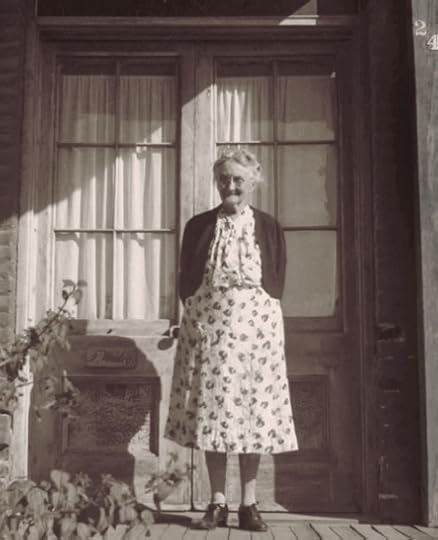 Lillian Whaley, December 16, 1945- Photo Courtesy SOHO collection
Lillian Whaley, December 16, 1945- Photo Courtesy SOHO collectionAfter burying Violet and Corinne Lillian’s heartbreak, the Whaleys couldn’t bear to stay. They relocated to New Town, where Mr. Whaley constructed a modest single-story residence at 933 State Street. Meanwhile, their brick home in Old Town stood empty most seasons, hosting only temporary tenants who invariably departed before their leases expired, due to unexplainable noises and occurrences.
After decades of tenants and neglect, the Whaley House in Old Town stood faded and crumbling by 1909. That year, Frank Whaley—the eldest son—returned to his childhood home of weathered brick and began its painstaking revival. Living within its restored walls, he transformed the building into a living museum, hanging hand-painted signs that boasted of its historical significance. Visitors who wandered through the former courtroom, now filled with carefully arranged artifacts, often lingered into the evening as Frank’s guitar melodies drifted through the rooms his father had built.
George and Lillian returned to the Whaley homestead in Old Town, leaving their State Street residence behind to serve as a rental property. The old house claimed Anna Whaley first, taking her at eighty-one on February 24, 1913. Her eldest, Frank, followed on November 19, 1914. George’s time came on Christmas Day, 1928. Only Lillian remained, keeping company with the family home and filling notebooks with her recollections until September 14, 1953, when she too departed at eighty-nine years of age.
Hauntings at the Whaley HouseThough Yankee Jim earned his place as the Whaley House’s first documented ghost, visitors have since encountered other unearthly residents. The distant cries of an infant pierce the silence without explanation, while a forlorn young woman materializes in the empty courtroom only to vanish moments later. In the parlor especially, guests often find themselves seized by an inexplicable sadness, their skin prickling with the certainty that unseen eyes follow their every move.
During guided tours, flashlights have inexplicably gone dark in visitors’ hands, while the distinct sound of wooden joints straining under invisible weight has emanated from vacant chairs. Guests with no prior medical conditions have experienced sudden vertigo and a creeping sense of dread that vanished the moment they stepped beyond the property line.
Final ThoughtsThe Whaley House was a childhood sanctuary for me, a regular pilgrimage whenever my mother shepherded my sister and me through Old Town. She’d weave tales of her youth in the area, stories that shimmered with strange possibilities. Have I encountered the spirits said to haunt those historic halls? I’ll keep that between myself and those weathered walls. But I can tell you this much—I’ve never questioned the legends that draw crowds of tourists to San Diego’s most notorious residence.
RIP Whaley Family- you will never be forgotten.
Father Thomas: Died in 1888 Mother Anna: Died in 1913 Corinne Lillian: Died in 1953 Thomas Jr. Died in 1858 of scarlet fever at 18 months Violet: Died by suicide at age 22 in 1885 Francis: Died in 1914Until next time, Keep Reading and Stay Caffeinated.
Subscribe below to stay up to date on myths, legends, mysteries, and the chaos of history.
FacebookThreadsInstagramAmazonX
If you’re looking for your next favorite read, I invite you to check out my book, The Raven Society. This spellbinding historical fantasy series takes us on a heart-pounding journey through forgotten legends and distorted history. Uncover the chilling secrets of mythology and confront the horrifying truths that transformed myths into monstrous realities. How far will you go to learn the truth?
The Writer and The Librarian (Book 1):
Signed copies at:
https://rlgeerrobbins.com/product/the-writer-and-the-librarian-the-raven-society-book-1/
Explore more blogs here:
October 8, 2025Unveiling Skull & Bones: America’s Secret SocietyEach year, fifteen of Yale's most promising seniors receive a tap on the shoulder—an invitation to join Skull and Bones, the … October 5, 2025Unveiling the Knights Templar: Secrets of a Shadowy BrotherhoodThe Knights Templar, a powerful brotherhood formed to protect pilgrims, amassed considerable influence and wealth, leaving an enduring legacy. But do … September 14, 2025Exploring Washington’s Legendary CreaturesLurking in the shadows of Washington’s dense forests and misty coastlines is a distinction many overlook: a bestiary of legendary creatures.August 5, 2025The Haunting of Myrtles PlantationLets head to the deep south to uncover the truth behind the events that earned the Myrtle Plantation the reputation of …Sources:
Paper Ghosts: The Ephemeral Legacy of the Thomas Whaley Family
#1 San Diego Haunted House | Whaley House Haunted Night Tour
lessonspioneerwhaleyfamily.pdf
Historic Resources Inventory.xls
The post Exploring One Of America’s Most Haunted House: The Whaley House appeared first on Chasing History.
October 8, 2025
Unveiling Skull & Bones: America’s Secret Society
Friends,
Fifteen elite souls are plucked from Yale’s junior class each year, anointed to carry the torch of America’s most notorious brotherhood. Their fortress—a brooding, windowless Neo-Gothic monstrosity locals call the “Tomb”—looms like a medieval specter off High Street. Pedestrians passing its stone façade feel a chill of dread mingled with forbidden curiosity.
What blood oaths are sworn in those lightless chambers? What savage rituals unfold beyond those impenetrable walls? The question burns in America’s collective imagination: why are we so desperately, so hungrily fascinated by what we cannot see?
Welcome to the world of the Skull & Bones.
 Members of Skull and Bones. Wikimedia.Background
Members of Skull and Bones. Wikimedia.BackgroundAfter immersing himself in Germany’s most exclusive esoteric circles—some that even fashioned themselves after the legendary Illuminati of the Enlightenment period—William Russell came back to Yale University with a vision. He sought to establish his own clandestine brotherhood and selected Alfonso Taft as one of its inaugural initiates, extending the ceremonial “tap” that would later become tradition.
 Manuscripts & Archives (Yale University)
Manuscripts & Archives (Yale University)A black wax seal, circa 1865, with the Skull and Bones emblem.
According to an alternate account, the society’s origins trace back to December 1832, when a dispute erupted among the Linonia, Brothers in Unity, and Calliopean Society debate clubs regarding that year’s Phi Beta Kappa honors. In response, William Russell, Alfonso Taft, and a handful of their fellow students abandoned their clubs to establish their own society, first calling themselves the Eulogian Club.
Skull & Bones wasn’t a name chosen after careful deliberation. Rather, it stuck after a founding member, posting a notice of their gathering on Yale’s chapel door—the customary bulletin board for undergraduates—impulsively drew a skull and crossbones symbol across the announcement. As he later confessed in writing, he’d done it merely “to attract attention and make a sensation among outsiders!” The symbol accomplished precisely that, and with remarkable effectiveness.
A Home for Skull & Bones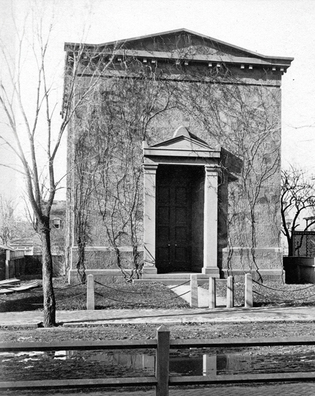 The New Haven Museum
The New Haven MuseumThe Skull and Bones tomb as it appeared in its original configuration, with just one rectangular, windowless block
In the early years society members met in rented rooms in commercial buildings in town. Members prized this escape from campus, understandably so given the dismal conditions of Yale College accommodations. The Old Brick Row dormitories that once stood where Old Campus now lies featured ceilings that drooped precariously, floors that creaked beneath one’s feet, walls fractured with age, and an atmosphere permeated by mildew. Warmth from coal-burning stoves fluctuated with available fuel, while the tallow candles and whale-oil lamps contaminated what breathable air remained.
Against such squalor, even the modest chambers secured by Bones would have represented sanctuary.
New Haven remained home to numerous Bones alumni who, having aged into the role of custodians, felt responsible for safeguarding both the society’s growing prestige and its accumulated treasures. These elder members established legal protection by incorporating under Connecticut law as the Russell Trust Association, through which they provided Skull & Bones with its first permanent headquarters.
What remains today as the left-hand block once formed the entire structure, its central doorway since replaced by a slotted window. Darker than its neighbors, the sandstone edifice presented a windowless face to the street. Iron doors—massive, tightly fitted, and towering twelve feet—bore the emblems of the society. Tin plates sheathed the nearly flat roof (iron plates, half an inch thick, would come later). Around the roof’s perimeter stood chimneys and ventilators, blocking the one skylight. The rear revealed only two small, iron-barred blind windows. At foundation level, barred scuttle holes provided the sole access to the cellar beneath.
Conspiracy Theories surrounding Skull & BonesAccording to whispers, The Tomb’s macabre collection includes the pilfered skulls of President Van Buren(1782–1862), Mexican revolutionary Pancho Villa (1878–1923) and Apache warrior Geronimo (1829–1909)—the latter supposedly exhumed by Prescott Bush in 1918.
When society tires of tales involving historical remains, conversation inevitably shifts to the society’s alleged blueprint for global control.
 Wikimedia Commons- Presidents Taft, H.W. Bush and W. Bush were all members of the Skull and Bones Society.
Wikimedia Commons- Presidents Taft, H.W. Bush and W. Bush were all members of the Skull and Bones Society.This paranoia gained traction when three Skull & Bones alumni ascended to the presidency, while the society’s deep CIA connections—through figures like James Jesus Angleton and the elder Bush—fueled whispers of a shadow government pulling intelligence strings from New Haven.
Some conspiracy theorists link the society to the shadowy Illuminati, while others credit Bonesmen with secretly orchestrating the development of the atomic bomb through the Manhattan Project.
Conspiracy theorists have even implicated the Skull & Bones in President Kennedy’s assassination, claiming that Mr. Bush’s position at the helm of Zapata Offshore—an oil company operating in the Gulf of Mexico—provided the perfect cover for recruiting Cuban operatives to carry out the Dallas shooting on that fateful November day in 1963.
Strange Rituals of Skull & Bones.Few outsiders know what truly happens during the society’s initiation ceremonies, leading to wild speculation about rituals involving everything from occult symbols to sacrificial animals laid across stone altars.
The truth behind the Skull & Bones rituals remains shrouded in mystery: Did Time founder Henry Luce really lie naked in a coffin confessing intimate secrets? Did William F. Buckley actually leap into mud during his initiation? Were the Bush dynasty members—Prescott, Bush Sr., and Bush Jr.—each gifted $15,000 with promises of lifelong financial security upon induction?
Despite decades of speculation in Esquire, The Atlantic Monthly, the New York Times, and countless books, these questions may forever remain unanswered.
Skull & Bones DiversifiesThe society’s exclusivity gradually eroded in the latter half of the twentieth century. Jewish students first crossed the threshold in the early 1950s, followed by the society’s first Black member in 1965—though notably, Yale football star Levi Jackson had declined an invitation fifteen years earlier, opting instead for Berzelius. A decade later, in 1975, the organization’s boundaries expanded further when they extended membership to the president of Yale’s gay student alliance.
While Yale University opened its doors to women in 1969, the Skull and Bones society maintained its male-only tradition for another 23 years. The society’s gender barrier finally cracked in 1991 when that year’s class selected seven female students for membership in the following year’s cohort.
This decision ignited fierce resistance from the old guard. Several prominent alumni—conservative pundit William F. Buckley Jr. among them—physically barred women’s entry by replacing the locks on the society’s headquarters, known as “The Tomb,” and initiated legal proceedings to prevent their induction.
The controversy was ultimately resolved through a second alumni referendum that endorsed women’s admission, leading to the lawsuit’s withdrawal and the historic initiation of the first female Bonesmen in 1992.
Final ThoughtsUnlike most secret societies, Skull & Bones has mastered the art of secrecy through strategic disclosure—offering just enough crumbs of information to satisfy public curiosity while keeping their true rituals, routines, and gatherings shrouded in mystery.
I must acknowledge the impenetrable nature of Skull & Bones despite my decades investigating secret societies in history. Skull & Bones has proven remarkably resistant to outside scrutiny, maintaining its mysteries even as I’ve uncovered others. Its strength lies in its structure—members spend only a brief period as active participants before joining the vastly larger, more influential alumni network that sustains its power across generations.
Until next time, Keep Reading and Stay Caffeinated.
Subscribe below to stay up to date on myths, legends, mysteries, and the chaos of history.
FacebookThreadsInstagramAmazonX
If you’re looking for your next favorite read, I invite you to check out my book, The Raven Society. This spellbinding historical fantasy series takes us on a heart-pounding journey through forgotten legends and distorted history. Uncover the chilling secrets of mythology and confront the horrifying truths that transformed myths into monstrous realities. How far will you go to learn the truth?
The Writer and The Librarian (Book 1):
Signed copies at:
https://rlgeerrobbins.com/product/the-writer-and-the-librarian-the-raven-society-book-1/
Explore more blogs here:
October 5, 2025Unveiling the Knights Templar: Secrets of a Shadowy BrotherhoodThe Knights Templar, a powerful brotherhood formed to protect pilgrims, amassed considerable influence and wealth, leaving an enduring legacy. But do … September 14, 2025Exploring Washington’s Legendary CreaturesLurking in the shadows of Washington’s dense forests and misty coastlines is a distinction many overlook: a bestiary of legendary creatures.August 5, 2025The Haunting of Myrtles PlantationLets head to the deep south to uncover the truth behind the events that earned the Myrtle Plantation the reputation of … May 4, 2025Mythology and Modern Life: Understanding Our Ancestral RootsThe Odin curse has hit me hard in the past few weeks. I have spent hours researching ancient beliefs only to …Sources:
“Change In Skull And Bones; Famous Yale Society Doubles Size of Its House – Addition a Duplicate of Old Building” (PDF). The New York Times. September 13, 1903. Retrieved November 5, 2011.
Yale, Skull and Bones, and the beginnings of Johns Hopkins – PMC
The origins of the tomb | Features | Yale Alumni Magazine
An American Conspiracy of the Lost Skull of a General Francisco VIlla
Yale’s Secret Society That’s Hiding in Plain Sight | TIME
The post Unveiling Skull & Bones: America’s Secret Society appeared first on Chasing History.
October 5, 2025
Unveiling the Knights Templar: Secrets of a Shadowy Brotherhood
Friends,
The list reads like a roll call of shadows: Skull and Bones, Illuminati, Priory of Sion, the Bohemian Club, Freemasons—mere whispers compared to the thunderous legacy of one brotherhood that dominated kingdoms, bent popes to their will, and amassed wealth beyond imagination before vanishing into the mists of history. The Knights Templar didn’t just exist—they conquered.
Even now, the Knights Templar haunts the shadows of modern society, their temples lurking in plain sight across the globe as powerful men swear oaths in midnight ceremonies, joining what is essentially a cabal of the elite—an impenetrable brotherhood where ancient secrets and modern influence collide behind locked doors.
But who exactly were the Knights Templar, and why, centuries after their dissolution, does their legacy still loom so large in our collective imagination?
Background
The First Crusade’s Christian victory at Jerusalem opened floodgates of Western European pilgrimage to the Holy Land. By 1118, these travelers faced such peril that a French knight, Hugues de Payens, established a military brotherhood for their protection. He named his order the Poor Knights of the Temple of King Solomon, though history would come to know them simply as the Knights Templar.
King Baldwin II of Jerusalem (1118-1131) granted the Knights Templar their first headquarters on the Temple Mount—the sacred site where, according to Christian belief, Abraham had prepared the altar for the sacrifice of his son Isaac.
Pope Honorius II formally recognized the Order during the council of Troyes in 1128CE, establishing the rigorous guidelines prescribed by Bernard of Clairvaux, a Cistercian monk and abbot. The knights adopted their distinctive white mantle, symbolizing their vow of purity, which Pope Eugenius later embellished with a crimson cross in 1146.
Rules of HonorBernard of Clairvaux, founder of the Templar’s, authored their governing document—the Rule of Life. Its 72 clauses demanded knights abandon worldly chivalry in favor of a higher calling: championing justice, protecting the vulnerable, and exercising restraint in combat.
The Rule placed extraordinary emphasis on sexual purity. Brotherhood knights lived under strict prohibitions against marriage and female companionship. t night? These poor saps had to sleep with the lights blazing and their scratchy tunics still on—heaven forbid a stray hand wander south during a dream.
Weird eating rules of the knights. Meat? Only three times a week—they thought too much would turn you into some kind of corrupt meat-beast. Sundays were stingy: one measly meal, maybe two if you were lucky. Mondays, Wednesdays, and Saturdays they’d get to eat two or three times, but only with boring veggie mush and bread. Fridays? Forget about it—total fast day. And from November 1st until Easter, they basically nibbled like mice, probably dreaming of giant turkey legs.
Daily LifeThe Templars were a bunch of holy warriors with a split personality disorder—half bloodthirsty knights, half pious monks—who lived by a schedule that would make even today’s most obsessive Type-A personalities twitch. Their days were chopped up by “canonical hours”—basically, the medieval version of iPhone calendar alerts, but for prayer. Picture this: you’re a Templar, snoring away, when—BOOM—4am Matins! Drag yourself out of bed, mumble some prayers, feed your horse (who’s probably giving you serious side-eye), then crawl back under your scratchy wool blanket until the 6am when the Prime bell yanks you back to consciousness
Between Tierce at 9am and Sext at noon, the brothers would be out with their horses—brushing, feeding, and training the beasts while secretly naming the most stubborn ones after their least favorite brothers. After Sext came the most torturous part of the day: lunch. Imagine trying to eat a hunk of mystery meat while Brother Chaplain droned through Leviticus and you couldn’t even whisper “what IS this?” to your neighbor. The afternoon dragged on with Nones at 3pm, Vespers and another silent meal at 6pm, and finally Compline at 9pm.
After Compline, the brothers would knock back a bit of watered-down vino before sneaking off to whisper sweet nothings to their horses until the midnight curfew bell, when the head honcho would shush everyone until the ungodly hour of 4am rolled around again
An Easy Path to PowerThe Knights Templar initially claimed their mission was protecting pilgrims traveling to sacred destinations, though historical evidence suggests this role diminished as their influence grew. This raises a compelling question: how did these warrior-monks achieve such profound historical significance in merely two centuries of existence?
 Templar knights at the time of the crusades. According to Saladin, they were ‘fiercest fighters of all the Franks’. Image: Alamy
Templar knights at the time of the crusades. According to Saladin, they were ‘fiercest fighters of all the Franks’. Image: AlamyThe answer is easy- they knew how to market themselves.
Hugh’s travels across Europe ignited widespread fascination with the Templar’s’ sacred mission. The capture of Jerusalem in 1099 had electrified Christian Europe, and by the late 1120s, this fervor remained undiminished. Aristocratic families, eager to honor relatives who had fought in the First Crusade, pledged resources to safeguard Christianity’s most precious conquest.
At least four European monarchs lent their considerable power to the organization: Baldwin II of Jerusalem, with his dwindling treasury and desperate need for skilled warriors, granted them quarters in his palace; Louis VII of France, fresh from a failed crusade, bestowed upon them extensive properties across his realm; Richard the Lionheart, between his bloody campaigns, entrusted them with royal finances and military support; and later Edward I of England expanded their landholdings throughout his kingdom despite his own ruthless taxation of other orders.
Following The MoneyBeyond their martial prowess, the Templar’s wielded influence through a vast web of more than 1,000 strongholds stretching from Jerusalem to Spain to the Scottish highlands—all funded by generous benefactors. This sprawling infrastructure underpinned what amounted to medieval Europe’s first multinational bank, a financial engine that fueled the Crusades.
Through this system, knights received stipends, monarchs secured war chests, and even the Papacy managed its finances. The Order pioneered portable credit notes, established history’s first ATM network, negotiated hostage releases, and extended credit when treasuries ran dry.
The FallKing Philip IV of France orchestrated the Knights Templar’s downfall to escape his enormous debts to them and claim their vast resources. Desperate to eliminate these powerful creditors, he manufactured accusations of blasphemy and leveraged his control over Pope Clement V to authorize their persecution. Templar’s throughout France were subsequently imprisoned, brutally interrogated, and put to death, culminating in the Pope’s formal disbandment of the order in 1312—effectively erasing medieval Europe’s most sophisticated financial bankers.
Final ThoughtsDespite whispers of secret survival, no genuine underground order persists. Today’s self-proclaimed Templar groups—whether raising funds for charity or donning period costumes for weekend tournaments—merely borrow the mystique of the name. They stand disconnected from the medieval warriors, their assertions of ancestral ties crumbling under historical scrutiny like ancient parchment exposed to light.
However, the blood-soaked legend of the Knights Templar continues to haunt our collective imagination, spawning countless fevered conspiracy theories, blockbuster films that dramatize their supposed occult knowledge, and an obsessive underground culture desperate to uncover the order’s allegedly hidden treasures and forbidden secrets.
In other words- the Knight Templar’s have never truly died.
Until next time, Keep Reading and Stay Caffeinated.
Subscribe below to stay up to date on myths, legends, mysteries, and the chaos of history.
FacebookThreadsInstagramAmazon
If you’re looking for your next favorite read, I invite you to check out my book, The Raven Society. This spellbinding historical fantasy series takes us on a heart-pounding journey through forgotten legends and distorted history. Uncover the chilling secrets of mythology and confront the horrifying truths that transformed myths into monstrous realities. How far will you go to learn the truth?
The Writer and The Librarian (Book 1):
Signed copies at:
https://rlgeerrobbins.com/product/the-writer-and-the-librarian-the-raven-society-book-1/
Explore more blogs here:
September 14, 2025Exploring Washington’s Legendary CreaturesLurking in the shadows of Washington’s dense forests and misty coastlines is a distinction many overlook: a bestiary of legendary creatures.August 5, 2025The Haunting of Myrtles PlantationLets head to the deep south to uncover the truth behind the events that earned the Myrtle Plantation the reputation of … May 4, 2025Mythology and Modern Life: Understanding Our Ancestral RootsThe Odin curse has hit me hard in the past few weeks. I have spent hours researching ancient beliefs only to … April 19, 2024Why I Study Mythology: A Historian’s JourneyYou think there are only starving artists in the world? Try being a historian.October 7, 2023Vampires- Myths, Legends, and TruthsVampires- a staple of Halloween, made popular by Stoker's novel, Dracula, and pop culture. Or could they be a creation of …Sources:
Explore the Medieval Era with Knights Templar
Timeline of the Crusades – Historic UK
The Succession to Baldwin II of Jerusalem: English Impact on the East on JSTOR
The post Unveiling the Knights Templar: Secrets of a Shadowy Brotherhood appeared first on Chasing History.
September 14, 2025
Exploring Washington’s Legendary Creatures
Friends,
From the infamous hijacker D.B. Cooper to the crisp orchards that feed a nation, from aviation giant Boeing to tech behemoth Amazon, and yes, the first-ever Starbucks Coffee Shop—Washington State boasts many claims to fame. Yet lurking in the shadows of its dense forests and misty coastlines is another distinction many overlook: a bestiary of legendary creatures that would make any cryptozoologist’s heart race.
Sasquatch (Bigfoot)Many cultures have their own names for the creature we commonly call Bigfoot, a term most associated with the Western mountains of North America. The Salish people gave us “Sasquatch,” derived from their word “Sasquits,” while further east, the Algonquin tribes speak of the fearsome “Witiko” or “Wendigo” stalking the forests of the north-central continent.
Across the continent, legends speak of a towering figure—nearly human in form but possessing extraordinary abilities beyond mortal men. Among the Ojibway people who roamed the Northern Plains, the Rugaru emerged only when peril loomed. Neighboring tribes shared this understanding: that this fur-covered visitor came not to harm but to herald, urging humans to alter their destructive paths before consequences arrived.
Though California lays claim to the first documented Bigfoot encounter in September 1958, it’s Washington state where the elusive creature seems to roam most freely. The Bigfoot Field Researchers Organization has cataloged more than 700 Washington sightings—more than any other state. Within Washington’s borders, Pierce County emerges as a particular hotspot, boasting 83 separate reported encounters, the densest concentration in the state.
 Photo by Gabe via Pexels
Photo by Gabe via PexelsThe state of Washington takes Bigfoot protection seriously. In 1969, Skamania County’s council enacted an ordinance making it a felony to harm a Sasquatch—violators face five years in county jail and fines up to $10,000. Decades later, Whatcom County followed suit, officially designating itself a “Sasquatch protection and refuge area” in 1991.
For more information or recent sightings, please visit the Bigfoot Field Researchers Organization here.
The Lake Chelan DragonLake Chelan plunges to depths of nearly 1,500 feet, making it America’s third-deepest lake. Indigenous storytellers spoke of vast cave networks beneath the water’s surface, where they claimed a creature known as N’hah’hahat’q made its home in the inky depths.
“Early Indians were very wary of canoeing on the Deep Lake (Lake Chelan) for fear of the monster that they called “N’hah’hahat’q”. Long ago there were great struggles between the good and bad spirits in the Chelan Valley. An evil spirit in the form of a large serpent would come out of the Chelan River without warning and destroy the homes of the people up and down the valley. At other times it appeared and scared away all the animals and fish. This left the Indians without food for long periods at a time.”
“The good spirit finally decided to put up a rock barrier at the lower end of the valley that would dam the river, trapping the serpent and killing it. Unfortunately, the monster did not die but became enraged instead. The serpent slashed his way up the valley killing all the Indians except for a lone girl picking berries at the top of the valley. The rising water left her stranded and she eventually died. However, before she died, she painted the story of her life on the rock walls. The stories have never been translated but can still be seen at Stehekin when the lake level is low.” (Hackenmiller, Tom. Wapato Heritage: the History of the Chelan and Entiat Indians. Point Pub., 1995.)
 Dan Coe Carto – Lake Chelan–Washington’s Deepest Lake
Dan Coe Carto – Lake Chelan–Washington’s Deepest LakeThe descendants of European colonists would later spread stories about a creature akin to Scotland’s fabled Nessie. According to their lore, Captain Chelan from the Highlands had smuggled one of the monster’s eggs aboard his ship during 1812 when the egg cracked open and a hatchling emerged.
In 1892, the creature surfaced again when three young men ventured into the lake’s waters. According to the two survivors, the dragon seized their companion by the leg with its jaws. Despite their desperate attempts to free him, they watched in horror as the beast took flight, their friend’s screams fading as predator and prey vanished into the clouds.
For more information on Lake Chelan’s Pirate festival and its famous dragon, please visit here.
The Basket OgressAmong the Salish people, stories circulate of the Basket Ogress—the Wild Woman who haunts woods and shorelines, gathering stray children into her woven trap before devouring them. Parents whispered these tales as twilight fell, ensuring their little ones understood the perils lurking within the state’s shadowy forests.
From the Strait of Juan de Fuca to the Strait of Georgia, the Salish tell this tale in over twenty languages across forty nations, each with its own name for the ogress and its own twist to the narrative. In every version, though, there are quick-witted children who find a way to slip through her grasp:
A group of children knew a woman who lived all alone near the river. The children knew that she was lonely, and they wanted to go visit with her. When they asked their parents for permission to go, their parents said, “No. You can’t go, because it is too far away: the Giant Woman might get you when you are away from home. The Giant woman is powerful. She would put you in her huge clam basket.”
The children ignored their parents. They got into a canoe and went on their way to visit the lonely woman. When night came, they made themselves a camp on the other side of the river. They built a fire and cooked their supper. One of the children was a liunchback. When the children divided their supper, Hunchback was given the tail part.
They traveled for several days. Each evening they would stop to camp overnight and eat their supper. Every time, they would give Hunchback the tail part for his share.
Hunchback finally said, “If you folks are always going to be giving me the tail part when I woulet really rather have the tips, I will call the Giant Woman!”
When night came again and they stopped to camp and eat their supper, it was still the tail part which he was given. Now Hunchback hollered! He hollered:
“Come downhill, Giant Woman, Come downhill, Giant Woman. It is just the tail part that I am given by my playmates ! “
The Giant woman heard right away. “Oh, there is someone hollering at me!” She put her basket on her back and she walked. She was a huge person, this Giant Woman. She chewed on everything as she traveled.
She arrived where the children were. Right away she began to pick up the children one by one and put them into her basket. She grabbed Hunchback first and put him there. When all of the childran were in the basket, the Giant Woman walked. she carried these children upland. suddenly she could feel something catch at her basket. She thought, “Oh, it must be Hunchback who has caught onto something.”
Hunchback had squirmed and squirmed until he managed to get himself up on top of the other children. Each time he came to a leaning tree he tried to grab ahold of it. No. He couldn’ t do it. On the fourth try, he did it.
Giant Woman went on walking. When she arrived at her home with the children she immediately gathered rocks and placed them on her fire to heat. When they were good and hot she began to take the children out of her basket. Then she found that Hunchback was missing. “Oh, Hunchback isn’t here ! Where is he? Maybe he managed to run away.”
Giant Woman ran!
Hunchback was in the canoe, shoving off from shore. He had a paddle with holes in it. This paddle had holes. When Giant Woman threw rocks at him, he held up his paddle and the rocks just went through. Hunchback paddled hard. Each time she threw a rock at him, he raised his paddle and the rock just went through a hole.
Giant Woman gave up. she went home and put more rocks on her fire. She wanted the rocks to be very hot to cook her supper fast.
The children huddled together and began talking to each other. They watched the Giant Woman heating all of those rocks on the fire.
Giant Woman noticed and said to them, “What are you children saying?”
The children carefully answred, “Oh, it is just that we are so happy for you that you are heating rocks. We would like for you to sing and dance before you cook us there.”
Giant Woman was so flattered at the request that she said, “All right!”
The children said, “You will dance!”
She proudly said, “Yes, I will.” Now Giant Woman danced. She sang this as she danced:
The children will be roasted on the rocks.
The children will be roasted on the rocks.
The children will be roasted on the rocks.
The children will be roasted on the rocks.
The children said, “Oh my, but your song is so nice. Sing more. ” And again Giant Woman sang and danced.
The oldest and strongest of the children were making plans: “We had better push her onto the hot rocks.”
Giant Woman asked, “What. are you children saying?”
They cautiously answered,, “Oh, we are just so happy for you.”
They whispered to each other, “When she comes near us, let’s all push her.”
Ohl Giant Woman was coming closer, singing:
The children will be roasted on the rocks
The children will be roasted on the rocks
The children will be roasted on the rocks
The children will be roasted on the rocks
As she came close to them, all of the oldest, strongest children pushed her. Right onto the hot rocks she fell. She screamed, “Remove me, children. Remove me from the fire and I will return you to your home. “
One of the children said, “Get a forked stick, and we shall remove your grandmother from the fire. We shall remove her. Get a forked stick.”
However, the children took the forked stick, and everyone pressed her down onto the hot rocks until she was just stuck there, roasting.
That is the end of the story.
This tale is told by 77-year-old Upper Skagit (Lushootseed) storyteller and elder Vi Hilbert, who has done a great deal to preserve her language, working with University linguists, and culture, in her work as a public storyteller and writer. The tale below is from her book, Haboo, Native American Stories from Puget Sound. Seattle: University of Washington Press, 1985 p. 42-44.
To explore more myths from the PNW area or learn about the different tribes and cultures, please visit here.
Final ThoughtsMonsters, goblins, and ghouls stalk the shadows far beyond European borders. They haunt every corner of our world, their blood-soaked legends pulsing through the veins of cultures across America. We MUST excavate these terrifying myths from the darkness of neglect, or risk the vengeful spirits of our forgotten histories rising to claim us all.
Until next time, Keep Reading and Stay Caffeinated.
Subscribe below to stay up to date on myths, legends, mysteries, and the chaos of history.
FacebookThreadsInstagramAmazonIf you’re looking for your next favorite read, I invite you to check out my book, The Raven Society. This spellbinding historical fantasy series takes us on a heart-pounding journey through forgotten legends and distorted history. Uncover the chilling secrets of mythology and confront the horrifying truths that transformed myths into monstrous realities. How far will you go to learn the truth?
The Writer and The Librarian (Book 1):
Signed copies at:
https://rlgeerrobbins.com/product/the-writer-and-the-librarian-the-raven-society-book-1/
Explore more blogs here:
August 5, 2025The Haunting of Myrtles PlantationLets head to the deep south to uncover the truth behind the events that earned the Myrtle Plantation the reputation of … May 4, 2025Mythology and Modern Life: Understanding Our Ancestral RootsThe Odin curse has hit me hard in the past few weeks. I have spent hours researching ancient beliefs only to … April 19, 2024Why I Study Mythology: A Historian’s JourneyYou think there are only starving artists in the world? Try being a historian.October 7, 2023Vampires- Myths, Legends, and TruthsVampires- a staple of Halloween, made popular by Stoker's novel, Dracula, and pop culture. Or could they be a creation of … October 6, 2023Discovering Sleepy Hollow: Myths and Legends UnveiledHave you ever wondered where the Ouija board originated. Or why? Learn the history behind the ability to talk to the …The post Exploring Washington’s Legendary Creatures appeared first on Chasing History.



